[ p. 351 ]
MAGDALENIAN TIMES — CLIMATE AND MAMMALIAN LIFE OF EUROPE — CUSTOMS AND LIFE OF THE CRO-MAGNONS; THEIR INDUSTRY IN FLINT AND BONE; THEIR DISTRIBUTION — DEVELOPMENT OF THEIR ART, ENGRAVING, PAINTING, SCULPTURE — ART IN THE CAVERNS — CLIMAX OF THE MAGDALENIAN ART AND INDUSTRY OF THE CRÔ-MAGNONS — APPARENT DECLINE OF THE RACE.
The art and industrial epoch of Magdalenian times is by far the best known and most fascinating of the Old Stone Age. This period forms the culmination of Palaeolithic civilization; it marks the highest development of the Crô-Magnon race preceding their sudden decline and disappearance as the dominant type of western Europe. The men of this time are commonly known as the Magdalenians, taking their name from the type station of La Madeleine, as the Greeks in their highest stage took their name from Athens and were known as the Athenians.
We would assign the minimum prehistoric date of 16,000 B. C. for the beginning of the Magdalenian culture, and since we have assigned to the beginning of the Aurignacian culture the date of 25,000 B. C., we should allow 9,000 years for the development of the Aurignacian and Solutrean industries in western Europe.
¶ Introduction. Industrial and Artistic Development
Well as this culture is known, its origin is obscured by the fact that it shows little or no Connection with the preceding Solutrean industry, which, as we have noted (p. 331), seems like a technical invasion in the history of western Europe and not an inherent part of the main line of cultural development. Thus Breuil1 observes that it appears as if the fundamental elements of the superior Aurignacian culture had contributed by some [ p. 352 ] unknown route to constitute the kernel of the Magdalenian civilization while the Solutrean episode was going on elsewhere. Again, early Magdalenian art bears striking resemblances to the superior Aurignacian art of the Pyrenees, especially the parietal art, as shown by comparing the Aurignacian engravings of Gargas with the early Magdalenian of Gombarelles. Moreover, the same author observes that, if there is one certain prehistoric fact, it is that the first Magdalenian culture was not evolved from the Solutrean— that these Magda lenians were newcomers in western France, as unskilful in the art of shaping and retouching flints as their predecessors were skilled. Ancient Magdalenian hearths are found in many localities close to the levels of the upper Solutrean industries with their shouldered spear points ('pointes à cran) and highly perfected flint work. Yet the Magdalenians show a radical departure from the Solutrean type of flint working; both in Dordogne (Laugerie Haute and Laussel) and in Charente (Placard) the splinters of flint are massive, heavy, badly selected, often of poor quality, and poorly retouched, sometimes almost in an Eolithic manner; at the same time, the chance flints, that is, the piercers and graving-tools made from splinters of any accidental shape, are abundant. To these people flint implements appear to be altogether of secondary importance; although the flints are very numerous, they are not finished with any of the perfection of the Solutrean technique ; the laurel-leaf spear head and shouldered dart head have disappeared entirely, but a great variety of smaller graving and chasing forms are employed for fashioning the implements of bone and horn. What a contrast to the beautiful flints so finely retouched and of such carefully selected materials, found in the very same stations in middle and upper Solutrean layers!
Thus Breuil, always predisposed to believe in an invasion of culture rather than in an autochthonous development, favors the theory of eastern origin for the Magdalenian industry, because this is not wanting either in Austria or in Poland; two sites of ancient Magdalenian industry have been found by Obermaier in the ‘loess’ stations of Austria, while in Russian Poland [ p. 353 ] the grotto of Maszycka, near Ojcow, exhibits workings in bone resembling those found at the grotto of Placard, Charente, in the layers directly succeeding the base of the Magdalonian. The fact that near the Ural Mountains there has also been found a peculiar Magdalenian culture, the origin of which is not western, inclines us to believe that the Magdalenian culture extended from the east toward the west, and then, later, toward the Baltic.
This theory of the eastern origin of the Magdalenian industry has, however, to face, first, the very strong counter-evidence of the close affinity between Aurignacian and Magdalenian art, which Breuil himself has done the most to demonstrate ; second, the physical, mental, and especially the artistic imity of the Crô-Magnon race in Aurignacian and Magdalenian times. The recent discovery of two Crô-Magnon skeletons together with two carved bone implements of Magdalenian type, at Obercassel, on the Rhine, links the art with this race and with no other, because, as we remarked above, an artistic instinct and ability cannot be passed from one race to another like the technique of a handicraft. Breuil2 himself has positively stated that the whole Upper Palaeolithic art development of Europe was the work of one race : if so, this race can be no other than the Crô-Magnon.
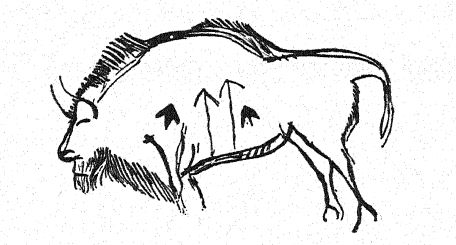

We must, therefore, revert to the explanation offered in a preceding chapter, that the Solutrean technique was an intrusion [ p. 354 ] or an invasion either brought in by another race or acquired from the craftsmen of some easterly race, perhaps that of Brünn, Brüx, and Predmost. Why the art of fashioning these perfect Solutrean spear, dart, and arrow heads was lost is very difficult to explain, because they appear to be the most effective implements of war and of the chase which were ever developed by Palaeolithic workmen.
It is possible, although not probable, that the bow was introduced at this time and that a less perfect flint point, fastened to a shaft like an arrowhead and projected with great velocity and accuracy, proved to be far more effective than the spear. The bison in the cavern of Niaux show several barbed points adhering to the sides, and the symbol of the fleche appears on the sides of many of the bison, cattle, and other animals of the chase in Magdalenian drawings. From these drawings and symbols it would appear that barbed weapons of some kind were used in the chase, but no barbed flints occur at any time in the Palaeolithic, nor has any trace been found of bone barbed arrow-heads or any direct evidence of the existence of the bow.
In compensation for the decline of flint is the rapid development of bone implements, the most distinctive feature of Magdalenian industry. In the late Solutrean we have noted the occasional appearance of the bone javelin points (sagaies) with [ p. 355 ] their decorative motifs; these become much more frequent in Magdalenian times. They occur in the most ancient Magdalenian levels of the grotto of Placard, Charente, which are prior even to the appearance of prototypes of the harpoon, the evolution of which clearly marks off the early, middle, and late divisions of Magdalenian times. These primitive javelins, decorated in a characteristic fashion, are found in Poland, at the grotto of Kesslerloch and other places in Switzerland, at many stations in Dordogne and the region of the Pyrenees in southern France, and in the Cantabrian Mountains of northern Spain.
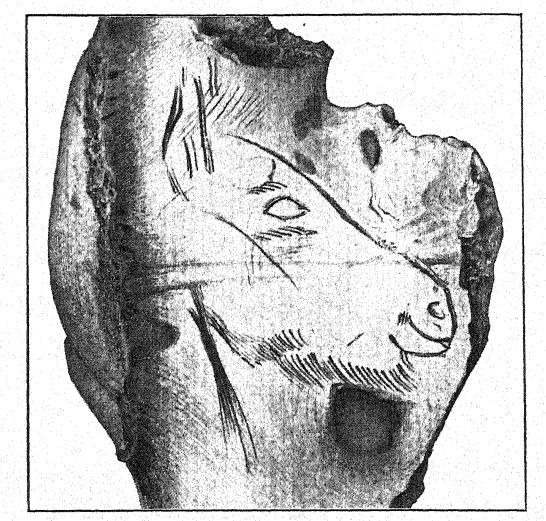
It is only above the levels where early types of these javelin points occur that the rudimentary harpoons of the typical early Magdalenian are found. The discovery of the bone harpoon as a means of catching fish marks an important addition to the food supply, which was apparently followed by a decline in the chase. Later, to the javelin, lance, and harpoon is added the dartthrower (propulseur), which gradually spreads all over western [ p. 356 ] Europe, where also the evolution of these bone implements and of the decoration with which they are richly adorned enables the trained archeologist to estabhsh corresponding subdivisions of Magdalenian time.
From the uniform character of Palaeolithic art in its highest forms of engraving, painting, and animal sculpture we may infer the probable unity of the Crô-Magnon race, especially throughout western Europe. During Magdalenian times various branches of art reached their highest point and were the culmination of a movement begun in the early Aurignacian. The artist, whose Hfe brought him into close touch with nature and who evidently followed the movements both of the individual animals and of the herds for hours at a time, has rendered his observations in the most realistic manner. Among the animals represented are the bison, mammoth, wild horse, reindeer, wild cattle, deer, and rhinoceros; less frequent are representations of the ibex, wolf, and wild boar, and there are comparatively few representations of fishes or of any form of plant life ; the nobler beasts of prey, such as the lion and the bear, are often represented, but there are no figures of the skulking hyaena, which at that time was a rare if not almost extinct animal. While many figures are of real [ p. 357 ] artistic worth and reach a high level, others are more or less crude attempts ; the composition of figures or of groups of animals is rarely undertaken.
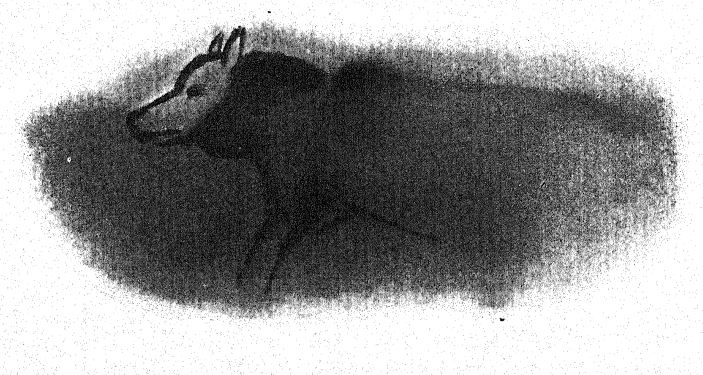
The artistic sense of these people is also manifest in the decoration of their household utensils and weapons of the chase. Here the smaller animals of the chase, the saiga, the ibex, and the chamois, are executed with a sure hand. Sculpture of animal forms in the large, which begins in Solutrean times, is continued and reaches its highest point in the early Magdalenian. At this period the use of sculpture as a means of decoration arises and extends into the middle and late Magdalenian. These latter divisions are also distinguished by the reappearance of human figurines, nude, like the Aurignacian, and occasionally somewhat more slender. Thus it would appear that the artistic spirit, more or less dormant in Solutrean times, was revived.

[ p. 358 ]
In the variety of industries we find evidences of a race endowed with closely observant and creative minds, in which the two chief motives of life seem to have been the chase and the pursuit of art. The Magdalenian flints are fashioned in a somewhat different manner from the Solutrean : long, slender flakes or ‘blades’ with little or no retouch are frequent, and in other implements the work is apparently carried only to a point where the flint will serve its purpose. No attempt is made to attain perfect symmetry. Thus the old technical impulse of the flint industry seems to be far less than that among the makers of the Solutrean flints, while a new technical impulse manifests itself in several branches of art: arms and utensils are carved in ivory, reindeer horn and bone, and sciflpture and engraving on bone and ivory are greatly developed. We find that these people are beginning to utilize the walls of dark, mysterious caverns for their drawings and paintings, which show deep appreciation for the perfection of the animal form, depicted by them in most lifelike attitudes.
We may infer that there was a tribal organization, and it has been suggested that certain unexplained implements of reindeer horn, often beautifully carved and known as ‘bâtons de commandement,’ were insignia of authority borne by the chieftains.
There can be little doubt that such diversities of temperament, of talent, and of predisposition as obtain to-day also prevailed then, and that they tended to differentiate society into chieftains, priests, and medicine-men, hunters of large game and fishermen, fashioners of flints and dressers of hides, makers of clothing and footwear, makers of ornaments, engravers, sculptors in wood, bone, ivory, and stone, and artists with color and brush. In their artistic work, at least, these people were animated with a compelling sense of truth, and we cannot deny them a strong appreciation of beauty.
It is probable that a sense of wonder in the face of the powers of nature was connected with the development of a religious sentiment. How far their artistic work in the caverns was an expression of such sentiment and how far it was the [ p. 359 ] outcome of a purely artistic impulse are matters for very careful study. Undoubtedly the inquisitive sense which led them into the deep and dangerous recesses of the caverns was accompanied by an increased sense of awe and possibly by a sentiment which we may regard as more or less religious. We may dwell for a moment on this very interesting problem of the origin of religion during the Old Stone Age, so that the reader may judge for himself in connection with the ensuing accounts of Magdalenian art.
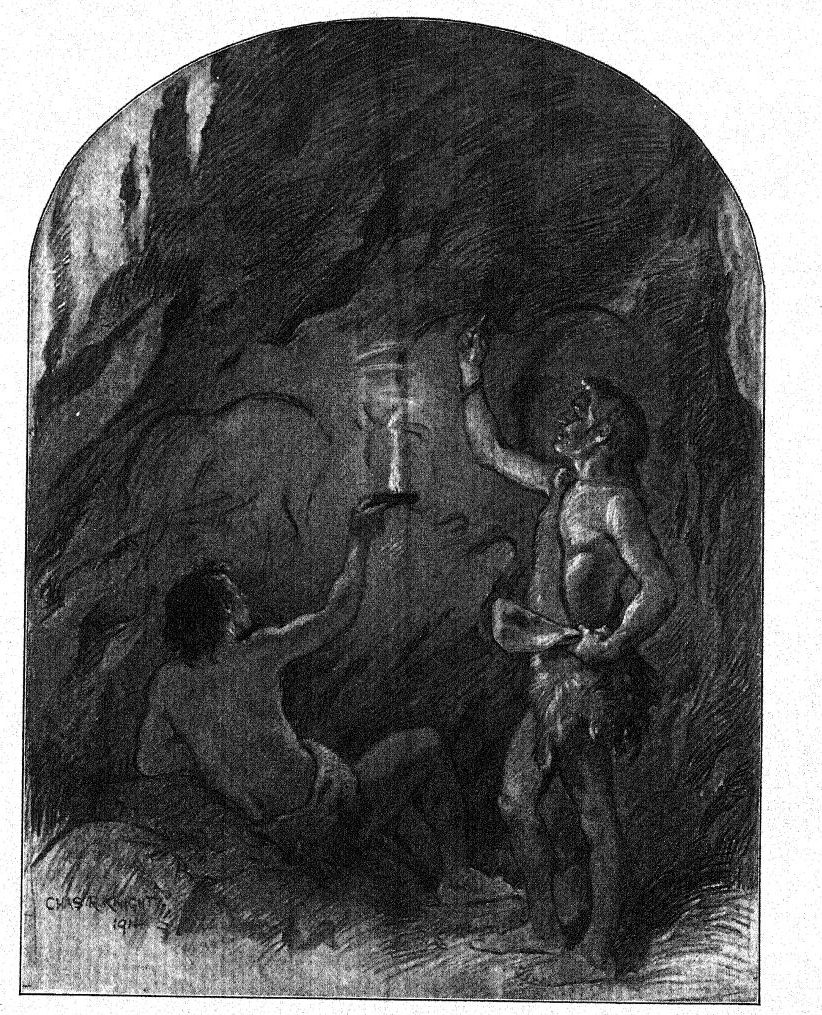
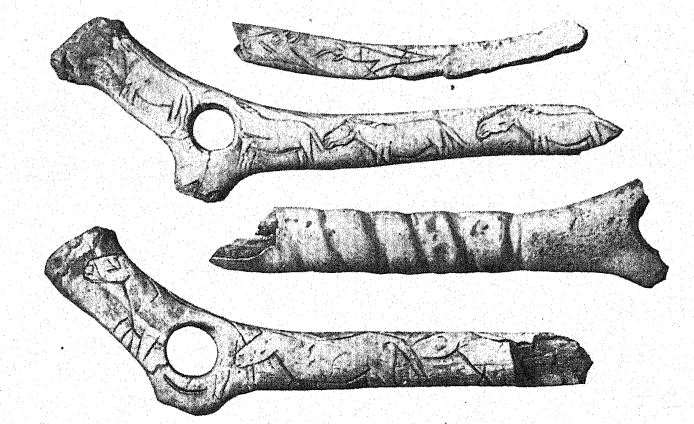
“The religious phenomenon,” observes James,3 “has shown itself to consist everywhere, and in all its stages, in the consciousness which individuals have of an intercourse between themselves and higher powers with which they feel themselves to be related. This intercourse is realized at the time as being both active and mutual. … The gods believed in —whether by crude savages or by men disciplined intellectually— agree with each other in recognizing personal calls. … To coerce the spiritual powers, or to square them and get them on our side, was, during enormous tracts of time, the one great object in our dealings with the natural world.”
[ p. 360 ]
The study of this race, in our opinion, would suggest a still earlier phase in the development of religious thought than that considered by James, namely, a phase in which the wonders of nature in their various manifestations begin to arouse in the primitive mind a desire for an explanation of these phenomena, and in which it is attempted to seek such cause in some vague supernatural power underljdng these otherwise unaccountable occurrences, a cause to which the primitive human spirit commences to make its appeal. According to certain anthropologists,[1] this wonder-working force may either be personal, like the gods of Homer, or impersonal, like the Mana of the Melanesian, or the Manitou of the North American Indian. It may impress an individual when he is in a proper frame of mind, and through magic or propitiation may be brought into relation with his individual ends. Magic and religion jointly belong to the supernatural as opposed to the every-day world of the savage.
We have already seen evidence from the burials that these people apparently believed in the preparation of the bodies of the dead for a future existence. How far these beliefs and the votive sense of propitiation for protection and success in the chase are indicated by the art of the caverns is to be judged in connection with their entire life and productive effort, with their burials associated with offerings of implements and articles of food, and with their art.
¶ The Three Climatic Cycles of Magdalenian Times
The culture of the Crô-Magnons was doubtless influenced by the changing climatic conditions of Magdalenian times, which were quite varied, so that we may trace three parallel lines of development: that of environment, as indicated by the climate and the forms of animal life, that of industry, and that of art.
The entire climatic, life, and industrial cycle of which the [ p. 361 ] Magdalenian marks the conclusion has been presented in Chapter IV (p. 281). After a very long period of cold and somewhat arid climate following the fourth glaciation, it would appear that western Europe in early Magdalenian times again experienced a stage of increasing cold and moisture accompanied by the renewed advance of the glaciers in the Alpine region, in Scandinavia, and in Great Britain. This is known as the Bühl stage in the Alps, in which the snow-line descended 2,700 feet below its present level and the great glaciers thrust down along the southerly borders of Lake Lucerne a series of new moraines distinctly overlying those of the fourth glaciation. Another indication of the lowered temperature and increased moisture in the same geographic region is found in the return of the arctic lemmings from the northern tundras; these migrants have left their remains in several of the large grottos north of the Alps, especially in Schweizersbild and Kesslerloch, composing what is known as the Upper Rodent Layer, with which are associated the implements and art objects of the early Magdalenian culture stage.
We have adopted the minimum estimate of 25,000 years since the fourth glaciation, but Heim^ has estimated that the much more recent prehistoric event of the advance of this minor Bühl glaciation began at least 24,000 years ago, that it extended over a very long period of time, and that the Bühl moraines in Lake Lucerne are at least 16,000 years of age.
The three climatic changes of Magdalenian times are therefore as follows :
First, the Bühl Postglacial Stage in the Alps, which corresponds with what Geikie has named the Fifth Glacial Epoch, or Lower Turbarian, in Scotland; for he believes that a relapse to cold conditions in northern Britain was accompanied by a partial subsidence of the coast lands, that snow-fields again appeared, that considerable glaciers descended the mountain valleys, and even reached the sea. At this time the arctic alpine flora of Scotland also descended to within 150 feet of the sea-level. The result of this renewed or fifth glaciation in [ p. 362 ] western Europe was the advent of the great wave of tundra life and the descent to the plains of all the forms of Alpine life.
Second, it would appear that in middle Magdalenian times, after the Bühl advance, there occurred a temporary retreat of the ice-fields, and that during this period the full tide of life from the steppes of western Asia and eastern Europe for the first time spread over western Europe, including especially such animals as the jerboa and the saiga antelope, the dwarf pika and steppe hamster. Correlation is very hazardous, but this ice retreat may correspond with the Upper Forestian, or Fifth Interglacial Stage in Scotland, described by Geikie, the stage which he mentions as marked by the elevation of the Scottish coast with the retreat of the sea beyond the present coast-lines; geographic changes which were accompanied by the disappearance of perennial snow and ice, and the return of more genial conditions. The tundra fauna still prevailed ; such a typical arctic animal as the musk-ox wandered as far south as Dordogne and the [ p. 363 ] Pyrenees, and became one of the objects of the chase. During what is known as the middle or ‘fuU Magdalenian’ the tundra, steppe, alpine, forest, and meadow faunae spread over the plains and valleys throughout western Europe.
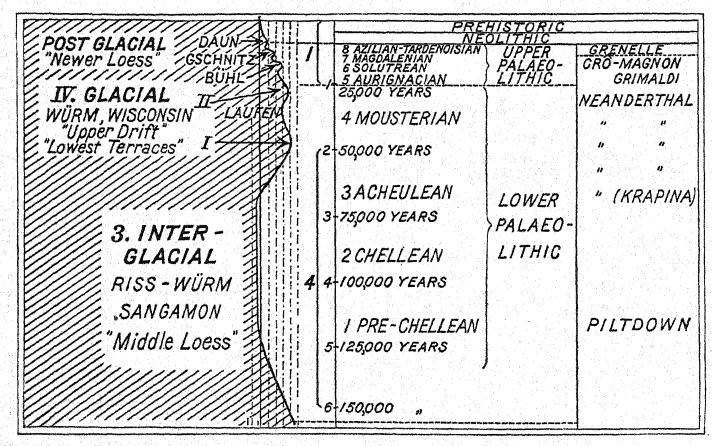
Third, the second Postglacial advance, known as the Gschnitz stage in the Alpine region, appears to have been contemporaneous with the closing period of Magdalenian culture. This was the last great ejffort of the ice-fields to conquer western Europe, and in the Alpine region the snow-line descended 1,800 feet below the present levels ; it marked the closing stage of the long cold climatic period that had favored the presence of the reindeer, the woolly mammoth, and the woolly rhinoceros in western Europe, as well as the close of the ‘Reindeer Epoch’ of Lartet. Again, in the north of Britain Geikie observes an Upper Turbarian or Sixth Glacial Epoch, accompanied by a partial subsidence of the Scottish coast, and the return of a cold and wet climate ; there is evidence of the existence of snow glaciers upon the high mountains only. The Gschnitz stage marks the end of glacial conditions in Europe, the retreat of the tundra and steppe faunae, and the predominance of the forest and meadow environment and life.
In the Alps there was, however, still a final effort of the glaciers, known as the Daun stage, which, it is believed, broadly corresponds with the period of the Azilian-Tardenoisian industry, and a climatic condition in Europe favorable to the spread of the Eurasiatic forest and meadow life.
The key to this great prehistoric chronology is found in palaeontology. The arctic tundra rodents especially are the most invaluable timekeepers ; according to Schmidt5 there is no doubt whatever that the Upper Rodent Layer, composed of the animals of the second invasion from the arctic tundras, corresponds, on the one hand, with the beginning of the Magdalenian industry and, on the other, with the renewed glacial advance in the Alpine region, known as the Bühl stage, and probably also with that in the north. The Upper Rodent Layer of Magdalenian times is found in the remarkably complete succession [ p. 364 ] of deposits at the stations of Schweizersbild and Kesslerloch, which are more recent in time than the ‘low terraces’ bordering the neighboring River Rhine. The fossil animals prove that after the extreme cold of early Magdalenian times the tundra fauna gradually gave way to a wide-spread steppe fauna. Along the Rhine and the Danube the banded lemmings become less frequent ; the jerboas, hamsters, and susliks of the steppes become more abundant. Exactly similar changes are observed in Dordogne. In Longueroche, on the Vézère, there occur for the first time in western Europe great numbers of rabbits (Lepus cuniculus); numerous baxts (Lepus timidus) are also observed at the type station of La Madeleine, especially in the uppermost and lowermost culture layers. These small rabbits probably came from the Mediterranean region and denote a slight elevation of temperature. But it is only in the very highest Magdalenian layers that the animal life of western Europe begins to approach that of recent times, namely, that of the prehistoric forest and meadow faunae.
¶ Mammalian Life of Magdalenian Times
Thus it is very important to keep in mind that during Magdalenian times there were both cold and moist periods favorable to tundra life and cold and arid periods favorable to steppe life. In the latter were deposited the sheets of ‘upper loess.’
The mammalian life of Magdalenian times- is of interest not only in connection with the chmate and environment of the Crô-Magnon race, but with the development of their industry and especially of their art. It is noteworthy that the imposing forms of animal life, the mammoth among the tundra fauna and the bison among the meadow fauna, made a very strong impression and were the favorite subjects of the draftsmen and colorists ; but the eye was also susceptible to the beauty of the reindeer, the stag, and the horse and to the grace of the chamois. The artists and sculptors have preserved the external appearance of more than thirty forms of this wonderful mammalian assemblage, which accord exactly with the fossil records preserved [ p. 365 ] in the fire-hearths of the grottos and shelters, and with the deposits assembled by beasts and birds of prey in the uninhabited caverns.
No artists have ever had before them at the same time and in the same country such a wonderful panorama of animal life as that observed by the Crô-Magnons. Their representations in drawing, engraving, painting, and sculpture afford us a view of a great part of the life of the period, including its contingent of forms from the tundras, steppes, Alpine summits, and Eurasiatic forests and meadows, and the one surviving member of the Asiatic fauna, the lion.
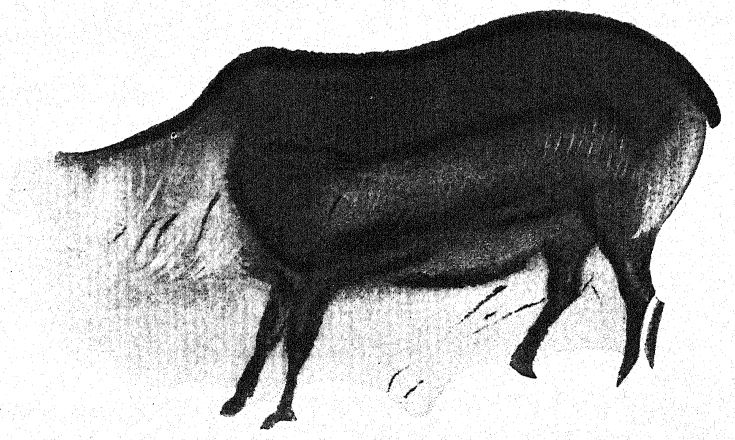
The paintings and drawings of Dordogne chiefly represent the mammoth, reindeer, rhinoceros, bison, horses, wild cattle, red deer, ibex, lion, and bear. The caverns of the Pyrenees of southern France present chiefly bison, horses, deer, wild cattle, ibex, and chamois; the reindeer and mammoth are relatively rare, and in some cases entirely wanting in the parietal art ; this is singular because in the Pyrenees the reindeer constituted the principal food of the authors of the drawings and frescos. In [ p. 366 ] the caves of the Cantabrian Mountains representations of the reindeer are entirely absent, while the doe and stag of the red deer are frequently pictured ; there are only a few representations of the mannmoth and one of the cave-bear. In the drawings of eastern Spain deer and wild cattle are abundantly represented, and there is undoubtedly a representation of the moose at Alpera.
As regards the sources of this great fauna, we have observed that in late Aurignacian and Solutrean times, at Predmost, Moravia, and elsewhere, the steppe fauna was not richly represented in western Europe, for it included only the steppe horse and the wild Asiatic ass or kiang; that the contemporary tundra fairna lacked two of the smaller but most characteristic forms, the banded and the Obi lemmings, although all of the large tundra forms were still widespread and freely intermingled with the forest and meadow life ; and that preying upon these herbivorous mammals were the surviving Asiatic lions and hyaenas.
The successive faunal phases of Magdalenian times, beginning with the early cold and moist or tundra period, have been determined with wonderful precision by Schmidt frorh the animal remains found associated with the lower, middle, and upper Magdalenian cultures in the grotto and cavern deposits of northern Switzerland, of the upper Rhine, and of the upper Danube. This region was lacking in some of the characteristic [ p. 367 ] animals seen in Dordogne, yet these invaluable records show that throughout the entire period of Magdalenian times, probably extending over some thousands of years, the forests, meadows, and river borders of western Europe maintained the entire existing, or rather prehistoric, forest and meadow faunae. The royal stag, or red deer (Cervus elaphus), was no longer accompanied by the giant deer (Megaceros), which apparently left this region of Europe in Aurignacian times, but the maral or Persian deer (Cervus maral) occasionally appears ; both the stag and the roe-deer (Capreolus) were especially abundant in southwestern Europe and the Cantabrian Mountains of northern Spain, where the stag became the favorite subject of the Magdalenian artists at the same time that the reindeer was the favorite subject in the region of Dordogne. In the forests were also the brown bear, the lynx, the badger, the marten, and in the streams the beaver ; tree squirrels (Sciurus [ p. 368 ] vulgaris) appear for the first time ; and in Dordogne rabbits and hares become numerous. Among birds we observe the grouse and the raven. The wild boar (Sus scrofa ferus) was occasionally found in the region of the Danube and the Rhine, but abounded in southwestern Europe and the Pyrenees. The two dominant forms of meadow life surviving from the earliest Pleistocene times, and widely distributed throughout the Magdalenian are the bison (B. priscus) and the wild cattle (Bos primigenius ) ; of these animals the bison appears to have been the more hardy, and seeking a more northerly range, while the urus was extremely abundant in southwestern’ France and the Pyrenees.
Favorite Art Subjects
Tundra Life.
- Mammoth.
- Woolly rhinoceros. Reindeer.
- Musk-ox.
Steppe Life.
- Steppe horse.
- Saiga antelope.
- Wild ass, kiang.
Asiatic Life.
- Lion.
- Desert horse.
Alpine Life.
- Ibex.
- Chamois.
Meadow Life.
- Bison.
- Wild cattle.
Forest Life.
- Red deer, stag.
- Forest horse.
- Cave-bear.
- Wolf.
- Fox.
- Wild boar.
- Moose.
- Fallow deer.
Sea Life.
- Seal.
Reptiles, Birds, Fishes.
- (Rarely depicted.)

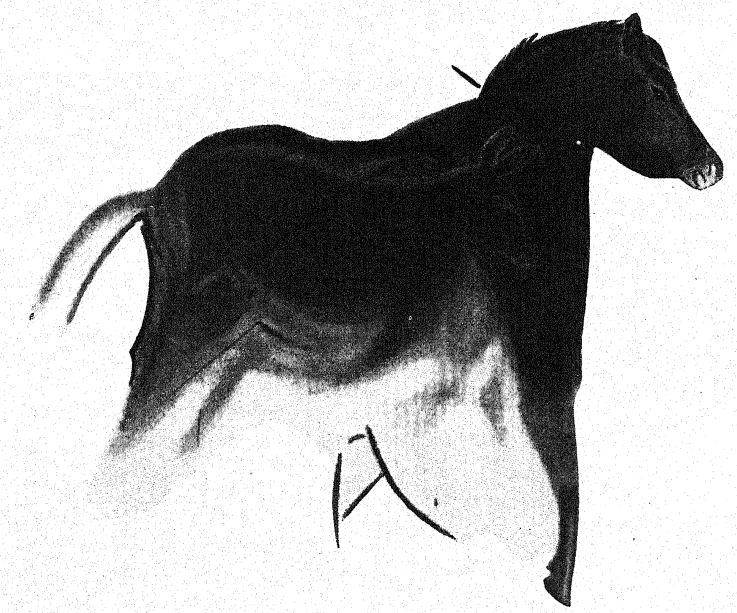
In connection with art, the majestic form of the bison seemed [ p. 369 ] to strike the fancy of the artist more than the less-imposing outlines of the wild cattle ; there are perhaps fifty drawings of the bison to one of the Bos. Among the forest and meadow life, not recognized in the fossil remains, but clearly distinguished in the work of the artists, are two types of horses, the forest or Nordic horse, related to the northern or draught horse, and the diminutive plateau or desert horse (E. caballus celticus) related to the Arab. With the forest life should also be numbered the cave bear (Ursus spelaeus) of southwestern Europe and the moose (Alces), indicated by the artists of Aurignacian times as present in the Cantabrian Pyrenees.
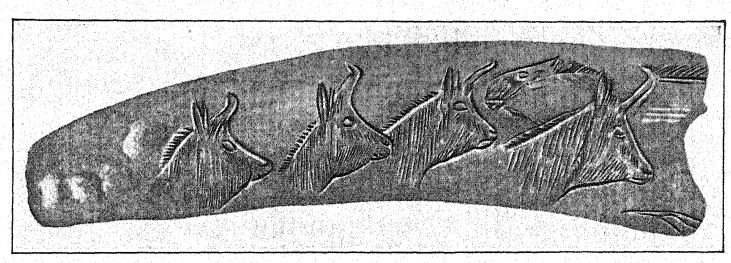
It is the above entire Eurasiatic forest and meadow fauna which survived all the climatic vicissitudes of Pleistocene time, and which alone remained in western Europe to the very close of the Upper Palaeolithic culture, and into the period of the arrival of the Neolithic race.
The descent of the European and Asiatic alpine types of mammals to the lower hills and valleys is one of the most striking episodes of Magdalenian times. The argali sheep (Ovis argaloides) of western Asia had already appeared in the upper Danubian region during the Aurignacian ; it is replaced in Magdalenian times by the ibex (Ibex priscus), and by the chamois, which descended along the northern slopes of the Alps and of the Pyrenees, and became numbered among the most highly favored subjects of the Magdalenian artists, especially in the [ p. 370 ] mobile art of ivory and bone, and in the decoration of their spear throwers and bâtons de commandement. From the mountains also come the pikas or tailless hares (Lagomys pusillus), the alpine marmot (Arctomys marmotta), the alpine vole (Arvicola nivalis), and the alpine ptarmigan (Lagopus alpinus).
¶ The Tundra Climate of Early Magdalenian Times
In the first cold moist period the full wave of arctic tundra life appeared in the whole region between the Alpine and Scandinavian glaciers during the renewed descent of the ice-fields; this was the timdra stage of early Magdalenian times, accompanying the Bühl advance. At the stations of Thaingen, Schweizersbild, Kastlhang, and Niedernau, appears the musk-ox, together with the woolly mammoth, the woolly rhinoceros, and the reindeer. The discovery of the grotto of Kastlhang, a reindeer hunting station in the Altmuhltale of Bavaria® fills out what has long been a gap in the geographic distribution of the early Magdalenian. The principal objects of the chase here were the reindeer, the wild horse, the arctic hare, and the ptarmigan; the royal stag is very rare, and the bison is wanting entirely; a strong arctic character is given to the fauna by the presence of the banded lemming, the arctic wolverene, and the arctic fox. From this region the musk-ox migrated far to the southwest, reaching the northern slopes of the Pyrenees. At the same time the arctic grouse, the whistling swan, and other northern birds entered the region of the Rhine and the Danube. But the surest indicators of a cold tundra climate prevailing during the period of the Bühl advance are the banded lemming (Myodes torquatus) and the Obi lemming (Myodes obensis), which are found in the same deposits with the arctic hare, the reindeer, and the woolly mammoth mixed with the implements of the early Magdalenian industry at the stations of Sirgenstein, Wildscheuer, and Ofnet along the upper and middle Danube. There also appear the ermine and the arctic wolverene; in fact, almost all the characteristic forms of tundra [ p. 371 ] [ p. 372 ] life except the polar bear, which only enters the northern tundras in the summer season.
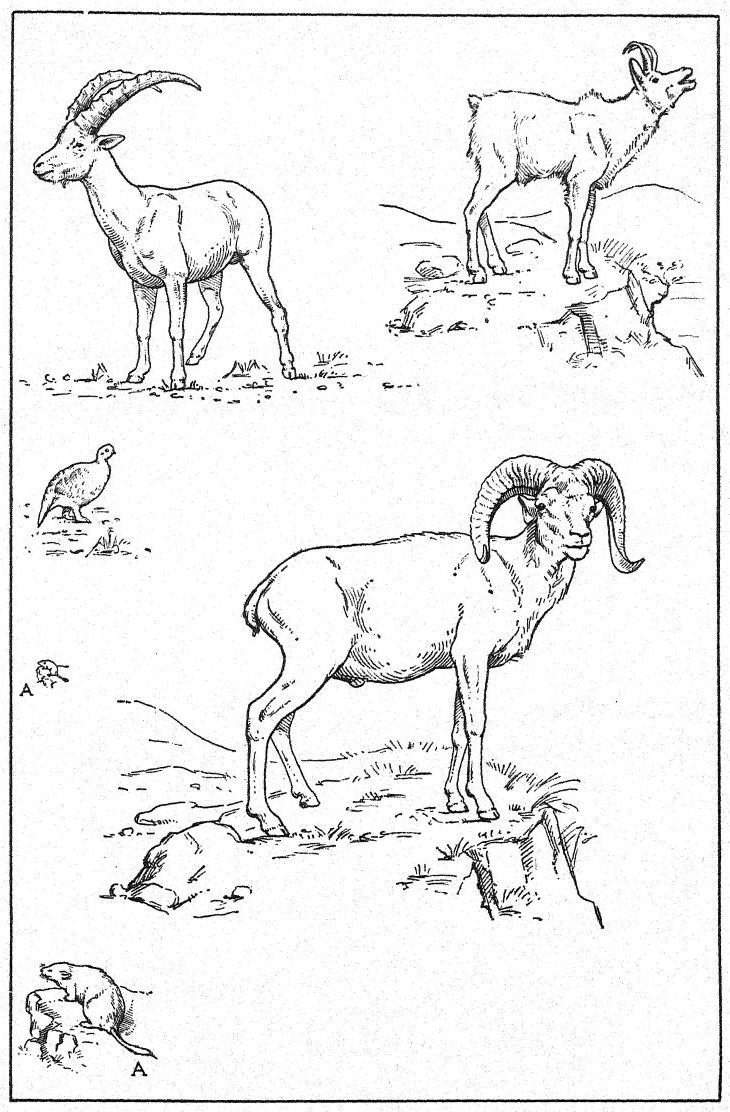
The regions of the northern Alps bordering the great glaciers of the Bühl and Gschnitz advances, were barren stretches of rock, and the valleys and plateaus now free from ice became tundras, where the swamps alternated with patches of polar willows and stimted fir-trees, while other areas were covered with low, scrubby birches, or reindeer moss and lichens. The return of these hard conditions of life undoubtedly exerted a great influence both upon the physical and mental development of the Crô-Magnon race; it was at the very period when the life conditions in western Europe were most severe that the artistic development of these people began to revive. Forced to return to the shelters and grottos, which certainly were less frequented in Solutrean times, there was time for the development of the imagination and for its expression both in the mobile and parietal arts. There was a less vigorous development of the flint industry, and apparently a degeneration in physique and stature.
In Germany and northern Switzerland, on the headwaters of the Rhine and the Danube, the entrance and departure of the northern waves of life are recorded, especially in the grottos of Sirgenstein, Schussenquelle, Andernach, Schmiechenfels, and Propstfels. It would appear that the woolly mammoth and the woolly rhinoceros were not hunted in this region, for their remains are not preserved in any of the grottos or stations mingled with the middle or late Magdalenian cultures. On the other hand, we find the steppe horse, the kiang, the stag, and the reindeer very abundant indeed. The bison is absent, and wild cattle are very rare ; so that this region is not typical of the mammalian life of Magdalenian times as found in Dordogne and in the Pyrenees.
The migration of the woolly manamoth and woolly rhinoceros along the Pyrenees and westward into the Cantabrian Mountains, and the crossing of the Pyrenees by the reindeer, have already been described. In the mural frescos of Font-de-Gaume, Dordogne, it is noteworthy that the very latest engravings are [ p. 373 ] those of the mammoth superposed on the fine polychromes which belong to the period of middle Magdalenian art.
¶ The Dry Steppe Climate op Middle Magdalenian Times
The cold, dry period, when the full tide of steppe life reached western Europe, is of somewhat uncertain date; it probably began during the stage of the middle Magdalenian industry and continued into the late or high Magdalenian. There was certainly an environment attractive to these peculiar and very highly specialized mammals, which at the present time are neutral in color, swift of foot, inured to existence on very sparse vegetation, and adapted to extremes of heat and cold. Among the smaller steppe forms were the suslik or pouched marmot of the steppes (Spermophilus rufescens) and the steppe hamster (Cricetus phaeus), also the Siberian vole (Arvicola gregalis) still more characteristic was the great jerboa (Alaciaga jaculus), with long, springy hind legs, and the saiga antelope (Antilope saiga). With these mammals appeared the steppe grouse (Perdix cinerea), which is found along the Danube in late Magdalenian strata; another bird characteristic of the northern steppes and tundras is the ‘woodcock owl’ (Brachyotus palustris). Accompanying these mammals was undoubtedly the steppe horse (Equus przewalski), now restricted to the desert of Gobi; it is said to occur in the grottos of northern Switzerland.
It would appear that the saiga antelope may have reached eastern Europe in late Solutrean times, for its outline is said to be fotmd in an engraving at Solutr^. Widely spread over Europe was the giant Elasmo there ; it would seem very unlikely that this animal was present in Magdalenian times, for it certainly would have attracted the attention of the artists. Neither have we any positive artistic records of the wild ass, or kiang, although certain of the drawings in the grottos of Niaux and Marsoulas, of the middle Magdalenian, also of Albarracin, in Spain, may be interpreted as representing this animal. Thus the Asiatic steppe and desert fauna, which in the region of the upper Rhine and [ p. 374 ] [ p. 375 ] Danube was restricted to two species of mammals in Aurignacian and Solutrean times, rises to nine or ten species in middle Magdalenian times, so that for the first time during the entire ‘Reindeer Epoch’ the steppe and tundra faunae are equally balanced. There are also six or seven species of birds from the moors and uplands of central Asia. The bird life depicted in middle Magdalenian art includes the ptarmigan or grouse, the wild swan, geese, and ducks.
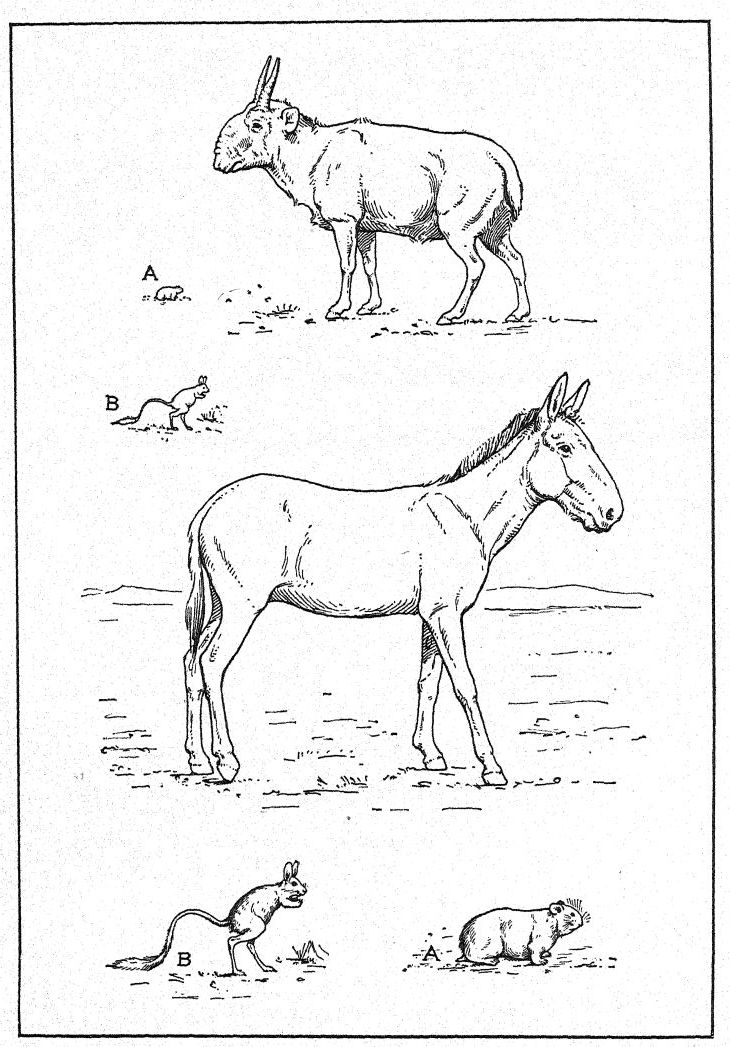
The present flora of the subarctic steppes in southeastern Russia and southwestern Siberia includes forests of pine, larch, birch, oak, alder, and willow, extending along the banks of the rivers and streams and interspersed with broad, low, grassy plains. There are many gradations between the low and high steppes;7 the climate in summer is relatively warm, the temperature rising to 70°, while the average temperature in mid-winter hardly exceeds 30° ; in general there is a strong contrast between the summer and winter seasons, the steppe lands in summer are practically rainless, so that the sand and dust rise with every wind. Thus, both in summer and winter sand and dust storms play an important role. The great snow-storms of the subarctic steppes are as destructive as those of the more northerly tundras and often result in great loss of life. Numerous discoveries tend to prove that similar conditions prevailed in western Europe during Magdalenian times. Thus at Châteauneuf-sur-Charente, a mingled tundra and steppe fauna is found containing the bones of many young animals which must have perished during a blizzard. It will be recalled that in this region is the station of Le Placard of late Solutrean and Magdalenian age. Near Wurzburg, Bavaria, [ p. 376 ] there is a fauna buried in the ‘loess’ containing twenty species of mammals of the txmdras and steppes, together with the bison and the urus.8
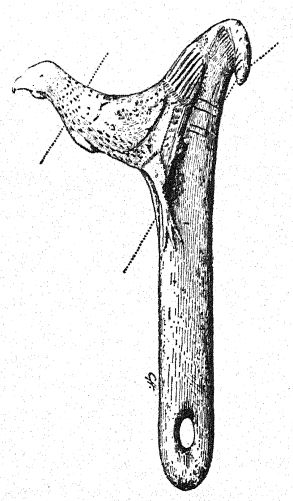
Perhaps the strongest proof of the extension of cold, dry steppe conditions of climate is the migration of the saiga antelope (Saiga tartarica) into the Dordogne region, where it is represented both in carvings and engravings, and into other parts of southwestern France, where its fossil remains have been found in thirteen localities in association with a cold steppe fauna. In the same region have been found the remains of the musk-ox (Ovibos), one of the most distinctive members of the arctic fauna.
¶ Human Races of Magdalenian Times
It appears that the Crô-Magnon race continued to. prevail, yet anthropologists have long been divided in opinion as to the racial affinity of the men found in the Magdalenian industrial stage. The most famous burials are those of Laugerie Basse and Chancelade in Dordogne, each consisting of skeletons of inferior stature, not improbably belonging to women. They certainly represent a race somewhat different from the typical Crô-Magnons of Aurignacian times, as found at Crô-Magnon and in Grimaldi. The archaeologist de Mortillet referred both these skeletons to a new race, the race de Laugerie. Schliz, who has most recently reviewed this subject, has, however, rightly treated all these people as Crô-Magnons of a modified type.
The Magdalenian skeleton of Laugerie Basse, found by Massenat in 1872, was resting on the back, with the limbs flexed, and with it was a necklace of pierced shells from the Mediterranean: the body apparently had been covered with a layer of Magdalenian implements. According to the length of the femur, the individual was 1.65 m., or 5 feet 1 inch in height; the bones were strong and compact; the skull was well arched, with a straight forehead and a cephalic index of 73.2 per cent.
The so-called Chancelade skeleton was found in the shelter of Raymonden in 1888, at a depth of 5 feet, and was also in a [ p. 377 ] folded position, resting directly on the rock and covered with several layers ol artifacts of the later Magdalenian culture ; the limbs were so tightly flexed as to prove that the had been enveloped in bandages. This skeleton shows a well-arched skull, a high, wide forehead, and a dolichocephalic head form, but the limbs are comparatively small, the height not exceeding 1.50 m., or about 4 feet 7 inches; the upper arm and thigh are short, compact, and clumsy, and the femur is crooked with comparatively thick ends ; this skeleton is generally classed with the Crô-Magnon race, but Klaatsch considers that it may belong to a distinct type. We cannot disregard, says Breuil,9 the anatomical characters attributed by Testut to the man of Chancelade and its resemblances to the actual Eskimo type ; this indication is in favor of a new element, arriving perhaps from Asiatic Siberia, but acquiring in western Europe the artistic culture [ p. 378 ] realized and conserved in certain districts by the Aurignacian tribes and their derivatives. All of the Aurignacian, Solutrean, and Magdalenian races, however, recall very forcibly the race of Crô-Magnon, which tends to prove that these transformations in culture were not made without a notable element of human continuity.
DISCOVERIES OF MAGDALENIAN AGE CHIEFLY ATTRIBUTED TO THE CRÔ-MAGN0N RACE[2]
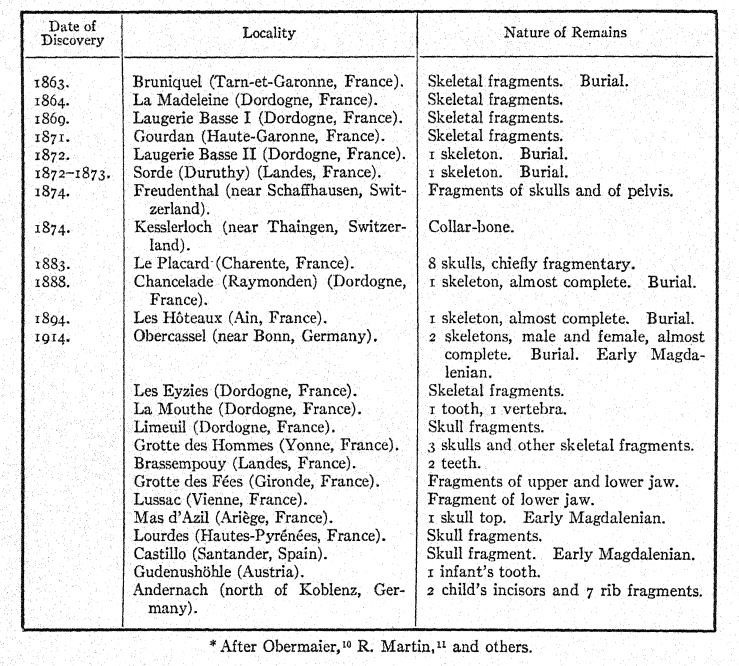
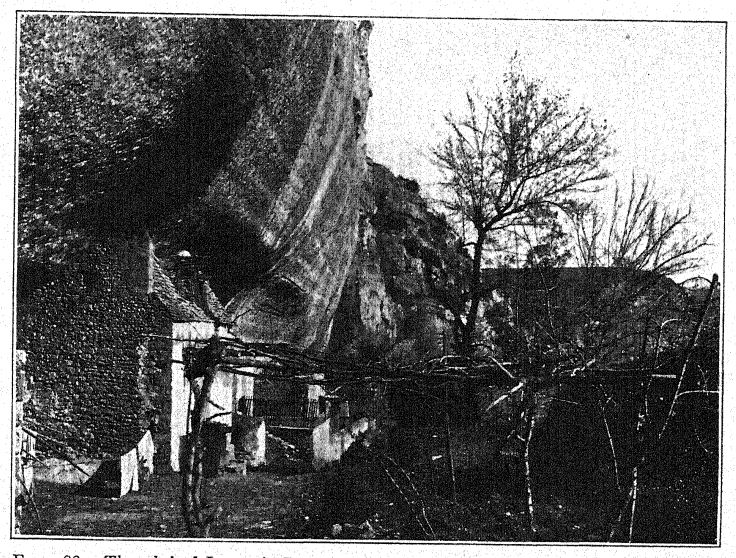
Another Magdalenian burial is that at Sorde, Landes, in the grotto of Duruthy; this skeleton was discovered in 1872, buried at a depth of 7 feet, the body being ornamented with a necklace and a girdle of the teeth of the lion and of the bear, pierced and engraved. Seven skulls found in 1883 in the grotto of Placard, Charente, also belong to the Magdalenian. The [ p. 379 ] skeleton discovered in 1894 in the grotto of Les Hoteaux, Ain, was buried at a depth of 6 feet beneath Magdaienian implements ; the body, resting on the back, was covered with red ochre ; the thigh-bones were inverted, indicating that the limbs had been dismembered before burial —a custom observed among certain savages.
These are the best preserved Magdaienian remains which have been discovered in France up to the present time. The matter of chief significance is the survival of modes of burial characteristic of the Crô-Magnons in Aurignacian times, with the use of color and of ornaments and with the body in some instances folded and bandaged.
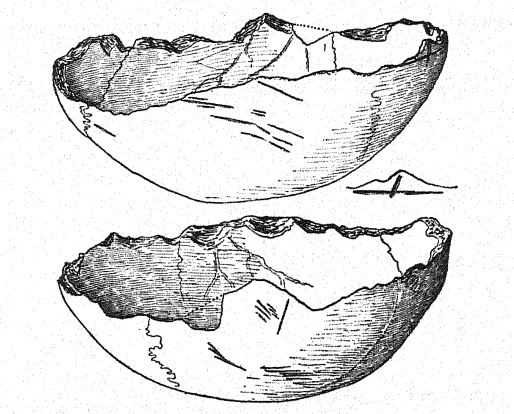
In the great grotto of Placard, near Rochebertier, Charente, a new feature in the mode of interment has been discovered —the separation of the head from the body.[3] The previous ceremonial burials, which began certainly among the Neanderthals in Mousterian times, alw-ays show the custom of burying the entire body ; in the Upper Paleolithic there commences the new custom of imbedding the body in ochre or red coloring matter, and this [ p. 380 ] obtains from the Aiirignadan burials of Grimaldi to the Azilian burial of Mas d’Azil. The flexing of the limbs occurs frequently in Upper Palaeolithic times. It would appear as if the new ceremonial of Placard had been introduced in the earliest Magdalenian times, for in the lowest Magdalenian layers four skulls were found closely crowded together, with the top of the cranium turned downward; of other portions of the skeleton only a humerus and a femur were found. In an upper layer of the same industrial stage a woman’s skull and jaw were found, surrounded by snail shells, many of them perforated. Still more singular is the occurrence in Magdalenian strata of this grotto of two separate skull- tops, fashioned by some sharp flint implement into bowls (Fig. 189).
Again, at Arcy-sur-Cure three skulls have been discovered placed closely together, and with them a flint knife in a layer superposed upon an Aurignaeian industry. The Placard type of burial of the head only is shown again in the Azilian stage at Ofnet, Bavaria.
The uncertainty regarding the racial affinity of the men of Magdalenian culture has now been entirely removed by the discovery, in February, 1914, of two skeletons at Obercassel, near Bonn, the first instance of complete human skeletons of Quaternary age being found in Germany.12 As reported by Verworn,i* the skeletons lay little more than a yard apart; they were covered by great slabs of basalt, and lay in a deposit of loam deeply tinged with red. This red coloring matter, which extended completely over the skeletons and surrounding stones, indicates that it was a ceremonial burial similar to that practised by the Aurignaeian Crô-Magnons. Along with the skeletons were found bones of animals and several specimens of finely carved bone, but no flint implements, of any kind. The bone implements include a finely polished Tissoir’ of beautiful workmanship, placed beneath the head of one of the skeletons; the handle is carved into a small head of some animal resembling a marten ; the sides show the notched decoration so typical of the French Magdalenian. The second specimen of carved bone is one of [ p. 381 ] the small, flat, narrow horse-heads, engraved on both sides, such as are found at Laugerie Basse and in the Pyrenees. One of the skeletons is of a woman about twenty years of age, and, as is usual in young female skeletons, it exhibits the racial characters in a much less marked degree than the male skeleton, which belongs to a man of between forty and fifty years ; the cephalic index is 70 per cent; the supraorbital ridges are well developed, and the orbits are distinctly rectangular; the limb bones indicate a body about 155 cm., or 5 feet i inch, in height.
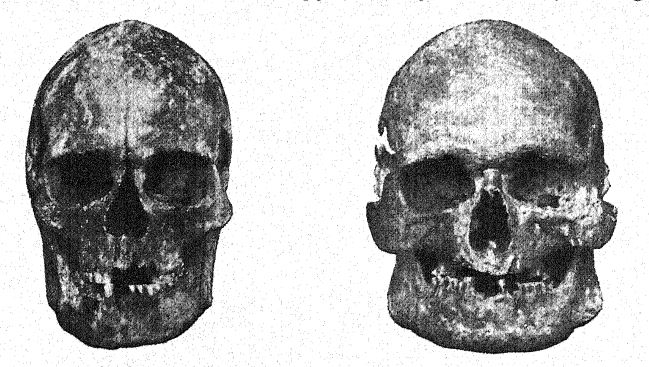
In contrast to this more refined skull, the extremely broad and low face of the man is entirely disproportionate to the moderately broad forehead and well rounded skullcap ; the breadth of the face is 153 mm. and exceeds the greatest width of the skull, which is only 144 mm. This is a markedly disharmonic type, the width of the face being due not only to the broad upper jaw but to the exceptional size and breadth of the cheek-bones. The skull is decidedly dolichocephalic, the cephalic index being 74 per cent; the brain capacity is about 1,500 c. cm. ; the orbits are rectangular, and above them extends an unbroken supraorbital ridge, with a slight median frontal eminence; the nasal opening is relatively small ; the lower jaw has a strongly marked cbin ; the crowns of the teeth have been worn down until the [ p. 382 ] enamel has almost disappeared. While the muscular attachments indicate great bodily strength, the height does not exceed 5 feet 3 inches. As pronounced Crô-Magnon features, both of the Obercassel skulls show an unusually wide face ; in both the profiles are straight and the root of the nose depressed, the nose is narrow, and the orbits are rectangular. But, observes Bonnet, the greatest width of these skulls is not found across the parietals, as in the typical Crô-Magnons, but just above the ear region, a much lower position; in this respect the Obercassel skulls resemble the skull of the Chancelade skeleton.
This very important discovery of two imdoubted descendants of the Crô-Magnon race associated with bone implements of lower Magdalenian workmanship appears to prove conclusively that the Crô-Magnons were the art-loving race. The Obercassel skeletons confirm the evidence afforded by the burials in France that these pecple were of low stature; perhaps because of the severe climatic conditions of Magdalenian times they had lost the splendid physical proportions of the Crô-Magnons living along the Riviera in Aurignacian times. The skull also, while retaining all the pronounced Crô-Magnon characters, had undergone a modification in the point of greatest width.
In the reduction of the stature of the woman to 5 feet x inch and of the man to 5 feet 3 inches, and in the reduction of the brain capacity to 1,500 c. cm., we may be witnessing the result of exposure to very severe climatic conditions in a race which retained its fine physical and mental characteristics only under the more genial climatic conditions of the south.
¶ The Four Industrial Phases of Magdalenian Culture
The industrial development belongs throughout to central and western Europe rather than to the Mediterranean. It is remarkable that it does not extend along the African coast, or even into Italy or southern Spain. It has been found to present four great steps or phases as follows :
The earliest types14 of the incipient Magdalenian culture or [ p. 383 ] PROTO-MAGDALENIAN, are nowhere better represented than under the great shelter of Placard, in Charente, where the deep successive deposits compel a realization of the long period of time required for the evolution of the Magdalenian with its wonderful artistic culmination. Even prior to any discovery of the harpoon or of any example of the art of engraving comparable to the classic series of higher levels we find three levels of incipient Magdalenian industry at Placard. Similar local horizons, recognizable from the type of their javelin points (sagaies) and from their decorative motifs, are also found at Kesslerloch, Switzerland, and as far east as Poland. From Dordogne they extend into the Pyrenees and into the Cantabrian Mountains of northern Spain, but not farther south. There is thus a very primitive Magdalenian industry wide-spread over central and western Europe, either autochthonous or influenced from the east, but certainly not from the Mediterranean. It is only above these [ p. 384 ] primitive horizons that layers are discovered with the rudimentary harpoons, and then with the perfected harpoons with single and double rows of barbs. It would appear as if the basins drained by the Dordogne and the Garoime were at once the most densely populated and also the centres from which industry, culture, and art spread to the east and to the west.
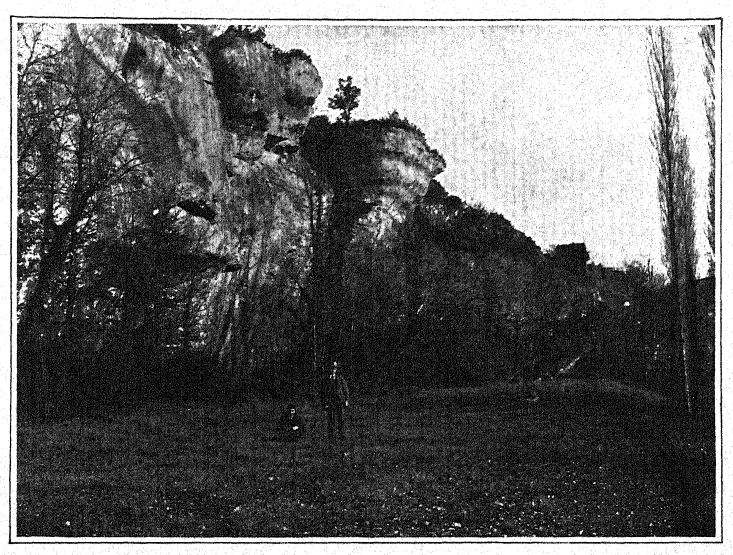
In the heart of the Dordogne region is the great rock shelter of La Madeleine, the type station of Magdalenian culture, and around it are no less than fifteen stations. This station, in which the lowest industrial layer (niveau inférieur) is subsequent to the Proto-Magdalenian phase and belongs to the early Magdalenian, was extensively excavated by Lartet and Christy during the decade following its discovery, in 1865, and more recently by Peyrony and others. The industrial deposit is situated at the base of an overhanging limestone escarpment on the right bank of the Vézère River ; it extends for a distance of 50 feet with an average thickness of 9 feet, the lowest or early Magdalenian levels reaching down below the present level of the Vézère. It is a significant fact that the river floods which from time to time occur here also occasionally drove out the flint workers in Magdalenian times. It indicates an unchaaged topography and similar conditions of rainfall. We must picture this cliff fringed with a northern flora, these river banks as the haunt of bison and reindeer, and the site of a long, narrow camp of skin-covered shelters.
Among the numerous specimens of typical Magdalenian industry and art which have been found here may be mentioned a geode of quartzite, apparently used to contain water, and stone crucibles, usually of rounded form, adapted to the grinding up of mineral colors for tattooing or artistic purposes; one of these crucibles, showing traces of color, still remains. The finest among the art objects is the spirited engraving, on a section of ivory tusk, of the woolly mammoth charging ; this is one of the most realistic pieces of Palaeolithic engraving which has ever been found ; there are indications that the artist used this relatively small piece of ivory for the representation of three mammoths ; [ p. 385 ] but in the reproduction (Fig. 199) all the lines are eliminated except those belonging to the single charging mammoth; we observe especially the elevation of the head and the tail, also the remarkably lifelike action of the limbs and body.
Very numerous industrial levels are discovered in eight or ten overlying hearths, which are, however, divided into three main levels, as follows :
Niveau superieur (late Magdalenian culture).
Harpoons with a double row of barbs. Indications that the climate was colder and drier, resembling that of Jthe steppes. Bison, horses, and reindeer abundant.
Niveau moyen (middle Magdalenian culture).
Harpoons with barbs on one side only; also bâtons de commandement. Indications that the climate was more moist, with frequent inundations from the river. Bison, reindeer, and horses less abundant.
Niveau inférieur (early Magdalenian culture).
Harpoons with a single row of barbs. Indications of animal sculpture. Ramins of bison and of reindeer, but those of horses especially numerous.
In the EARLY MAGDALENIAN we note the invention of the harpoon; its first crude form is that of a short, straight point of bone, deeply grooved on one face, the ridges and notches along one edge being the only indications of what later develop into the recurved barbed points of the typical harpoon. As noted above, this invention was destined to exert a very strong influence on the habits of these people. Large fish undoubtedly were very abundant in all the rivers at that time, and this new means of obtaining an abundant food supply probably diverted the Crô-Magnons in part from the more ardent and dangerous pursuit of the larger kinds of game. The discovery soon spread, and among a number of localities where prototyes of the harpoon are found may be mentioned Placard, in Charente; Laugerie Basse, in Dordogne ; Mas d’Azil, on the Arize ; and Altamira, in northern Spain. In the early Magdalenian also a great variety of flint drills or borers are developed in connection with the fashioning of bone, including the ‘parrot-beak’ type, or [ p. 386 ] recurved flint. The microlithic flints, exclusively designed for fine and delicate artistic worK, are more abundant than in any previous stage, and were used to shape and finish the bone implements which chiefly distinguish the Magdalenian culture. Other implements which enable us to recognize the early Magdalenian [ p. 387 ] culture layers are javelin points of bone or reindeerhorn with oblique bases, small staves of reindeer-horn or ivory, oval plates of bone frequently decorated with engraved designs, and slender, finely finished needles.
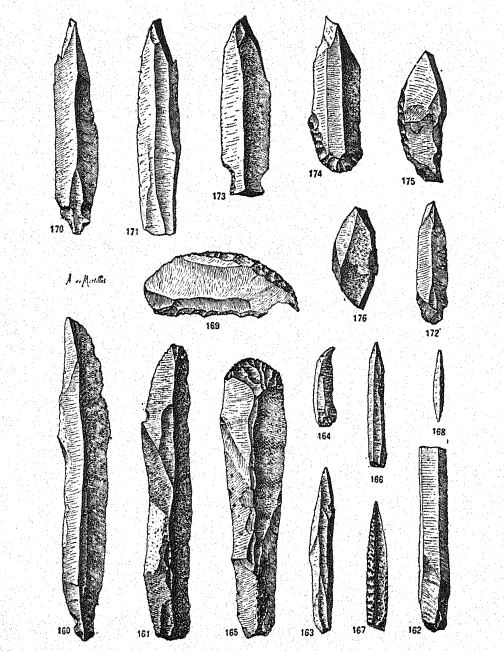
The Middle Magdalenian implements were more widely distributed than the early tjpes, the most characteristic weapon being the harpoon with a well-defined single row of barbs (Breuil,16 Schmidt17). According to Breuil, this single-rowed harpoon is rare in the lower layers but abimdant in the upper layers of middle Magdalenian times ; with it occur examples of the singlerowed harpoon with swallow-tail base. Other implements of this stage are the bone javelin points with cleft base, small bone staves richly decorated, also numerous needles, finer and more slender than those of the early Magdalenian. It is very interesting to note that there are no distinctive inventions in the flint industry, which shows no important advances, although microlithic flints are still more abundant than before. For industrial purposes scrapers continue to be very abundant, as well as borers for the perforation of bone implements. The [ p. 388 ] middle Magdalenian industry is best represented in the deposits of central and southern France, at Raymonden, Bruniquel, Laugerie Basse, Gourdan, Mas d’Azil, and Teyjat.
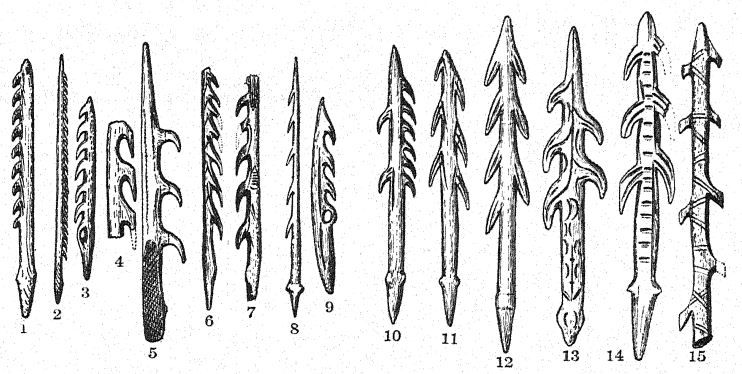
The chief weapon of LATE MAGDALENIAN times is the harpoon with the double row of barbs, which is found at all the principal discovery sites extending from stations in southwestern and southern France far to the east. Besides the double-rowed harpoon, the cylindrical chisel of reindeer-horn frequently occurs, often pointed at the end and with a small curve at the side ; this, like other bone implements, was richly decorated with engraving. This late Magdalenian level is distinguished everywhere by the rich decoration of all the bone implements and weapons, as well as of the ‘bâtons de commandement.’ The quantity of bone needles, more numerous in this stage than ever before, attests the greater refinement of finish in the preparation of clothing.
This was the culminating point both in Magdalenian industry and art, and probably also in the morale and modes of living. Characteristic types of this late Magdalenian culture are found at La Madeleine, Les Eyzies, and Teyjat, and extend into the northern Pyrenees, at Lourdes, Gourdan, and Mas d’Azil. Their easterly geographical distribution will be described on a later page. The microlithic flints now reach their culminating point; to the small bladed flakes with blunted backs are added little feather-shaped flint blades, and still others with oblique ends, which begin to suggest the geometric forms of the succeeding Tardenoisian industry. Among the flint borers we notice a prevalent type with a stout central point, also the so-called ‘parrot-beak’ borer; for the preparation of skins, scrapers are made, as before, of thin flakes, slightly retouched at both ends to give a rounded or rectangular form.
Following the late or high Magdalenian stage is a period of decline in industry. In southern France18 both flint and bone implements show unmistakable indications of the approach either of the succeeding Tardenoisian or Azilian stage. In the Pyrenees both the flints and the great poUshers of deer-horn begin to resemble those which occur in the post-Magdalenian levels. [ p. 389 ] This industrial stage corresponds broadly with the period of decline in art, and with the change both in the industrial habits and in the artistic spirit of the Crô-Magnons.
The divisions of the Magdalenian are, therefore, as follows :
5. Decline of the Magdalenian art and industry.
4. Late Magdalenian typified at La Madeleine, Dordogne.
3. Middle Magdalenian typified at La Madeleine, Dordogne.
2. Early Magdalenian typified at La Madeleine, Dordogne.
1. Proto-Magdalenian typified at Placard, Charente.
¶ Flint and Bone Industry
Through the four successive stages of development which we have already traced (p. 382) there are perceived certain general tendencies and characteristics which clearly separate the Magdalenian from the preceding Solutrean culture.
Compared with Solutrean times, when the art of flint working reached its high-water mark, the Magdalenian palseoliths show a marked degeneracy in technique, having neither the symmetry of form nor the finely chipped surfaces which distinguish the Solutrean types ; indeed, they do not even equal the grooved marginal retouch of the best Aurignacian work. The Magdalenian retouch shows no influence of the Solutrean; it is even more blunt and marginal than the late Aurignacian. In compensation for this decadence in the art of retouch, the Crô-Magnons now show extraordinary skill in producing long, narrow, thin flakes of flint, struck off the nucleus with a single blow; these ‘blades,’ which are very numerous, are often not retouched at all; occasionally a few hasty touches are used to attain a rounded or oblique end ; in other cases a very limited marginal chipping along the sides or the development of an elongated pedicle (soie) produces very effective implements for graving and sculptural work.
For the art of engraving perfect burins, burin-grattoirs, and burins doubles were rapidly made from these thin flakes; also burins with oblique terminal edge and with the ‘parrot-beak’ end. For industrial purposes some of the flints were denticulated around the border, doubtless for the preparation of fibres [ p. 390 ] and of thin strips of leather for the attachment of clothing to the body and for binding of the flint and bone lance-heads to wooden shafts. Extremely fine pergoirs have been found adapted to perforating the bone needles; the grattoir, single or double, was also fashdoned out of these flakes, and the nucleus of the flint was used as a hammer. Hammers of simple rounded stones are also found.
But the notable feature of Magdalenian industry is the extensive and unprecedented use of bone, horn, and ivory. From the antlers of the reindeer are early developed the sagaies or javelin points of varying size, usually ornamented along the sides and with several forms of attachment to the wooden shaft, either forked, bevelled, or rounded. The ornamentation consists of engraved elongate lines or beaded lines, and of deep grooves perhaps intended for the insertion of poisonous fluids or the outlet of blood.

Of all the Magdalenian weapons the most characteristic is the harpoon, the chief fishing implement, which now appears for the first time marked by the invention of the barb or point retroverted in such a manner as to hold its place in the flesh. The barb does not suddenly appear like an inventive mutation, but it very slowly evolves as its usefulness is demonstrated in practice. The shaft is very rarely perforated at the base for the attachment of a line ; it is cylindrical in form, adapted to the [ p. 391 ] capture of the large fish of the streams. That a barbed weapon was also used in the chase seems to be indicated by drawings in the grotto of Niaux and lines engraved on the teeth of the bear, but these drawings indicate the form of an arrow rather than of a harpoon. The length varies from two to fifteen inches. The harpoons may have been projected by means of the so-called propulseurs or dart-throwers, which resemble implements so employed by the Eskimo and Australians of to-day. These dart-throwers are often beautifully carved, as in the case of one found at Mas d’Azil, ornamented with a fine relief of the ibex.
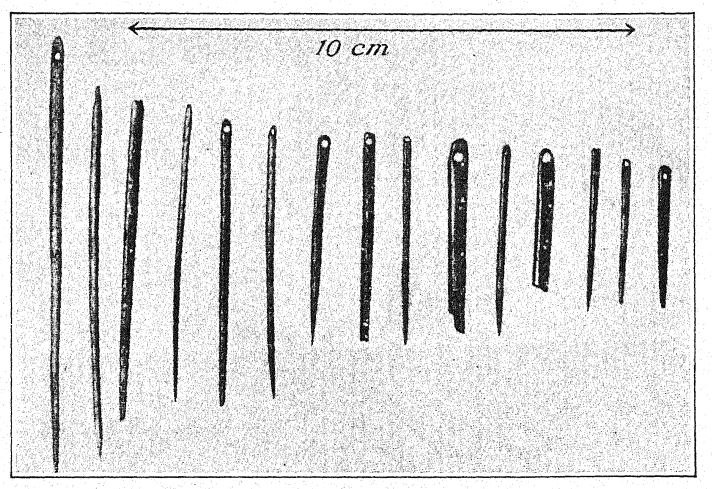
Then there were bâtons de commandement, carved with scenes of the chase and with spirited heads of the horse and other animals, which quite probably were insignia of ofl&cc. Reinach has suggested that bâtons were trophies of the chase, and according to Schoetensack they may have been used as ornaments to fasten the clothing. The discovery of mural painting and engraving suggests the possibility that these bâtons were believed to have some magical influence, and were connected with mysterious rites in the caverns, for a great variety of such ceremonial [ p. 392 ] staffs is found among primitive peoples. Geographically, the bâtons spread from the Pyrenees into Belgium and eastward into Moravia and Russia.
Slender bone needles brought to a fine point on stone polishers indicate great care in the preparation of clothing. Associated with the borers are many other bone implements: awls, hammers, chisels, stilettos, pins with and without a head, spatulas, and polishers ; the latter may have been employed in the preparation of leather. The borers, pins, and polishers appear from the very beginning of the period of sculpture. The name of poniard (poignard) is given to long points of reindeer-horn; one of these was found at Laugerie Basse.
¶ History or Upper Paleolithic Art
Following the pioneer studies of Lartet, the history of the art of the Reindeer Period, as manifested in bone, ivory, and the engraved and sculptured horns of the deer, occupied the last thirty-five years of the life of Edouard Piette,^® a magistrate of Graonne who pursued this delightful subject as an avocation. He was a pioneer in the interpretation of l’art mohilier, the mobile art. It must be remembered that in Piette,19 time the fourfold divisions of Upper Palaeolithic culture so familiar to us were only partly perceived ; his studies, in fact, related chiefly to the mobile art of Magdalenian times, and he undertook to follow its modifications in every successive grotto, beginning with his brochure La Grotte de Gourdan, in 1873, in which he first announced the idea which underlay all his later conclusions, that sculpture preceded line engraving and etching. He divided the art into a series of phases ; that of the red deer (Cervus elaphus) he termed Elaphienne, that of the reindeer Tarandienne, that of the horse Hippiquienne, and that of the wild cattle Bovidienne. In concluding this early work of 1873, he remarked: “To write the history of Magdalenian art is to give the history of primitive art itself.” He observed that in sculpturing the horn of the reindeer the artist was obliged to work in the hard exterior, bone and to avoid the spongy interior ; this defect in material suggested [ p. 393 ] the invention of the bas-relief. The statuette he regarded as the assemblage of two bas-reliefs, one on either side of the bone. Thus he described the ivory head of the woman of Brassempouy, the only human face of Upper Palaeolithic times which is even fairly well represented; also the two imperfect feminine torsos in ivory. In 1897, at the age of seventy, Piette undertook his last excavations, and the sum of his labors is preserved for us in the magnificent volmne entitled l’Art pendant l’âge du Renne, published in 1907.
The pupil and biographer of Piette, l’Abbé Henri Breuil, observes that his scheme of art evolution is exact along its main lines.20 It is true that human sculpture appears for the first time in the lower Aurignacian, that it survives the Solutrean, and even extends into middle Magdalenian times, but this enormous period cannot be placed in one archaeological division as Piette supposed; in truth, he did not suspect the prolonged gestation of Quaternary art, but contracted into one small division the documents of numerous phases. At the same time, Piette was right in attributing the flower of the art of engraving accompanied by contours of animal forms in relief to the second and third levels of the Magdalenia,n industry, but he had no idea that this development had been preceded by a long period in which engraving had been practised in a timid and more or less sporadic manner as a parietal art on the walls of the caverns as well as on bone and stone. It is also true that a considerable facility in sculpture preceded the art of engraving, but it was arrested in its progress while engraving slowly developed ; in the early choice of subjects the sculptors of middle and late Aurignacian times showed a preference for the human form, while later, in Solutrean and early Magdalenian times, they inclined principally toward animal figures, so that sculpture was not suddenly eclipsed. The first engravings made with fine points of flint on stone are hardly less ancient than the first sculptures, and modestly co-exist beside them up to the moment where engraving, greatly multiplied, largely supplants sculpture. Finally, observes Breuil, it is one of the glories of Edouard Piette [ p. 394 ] to have understood that the painted pebbles of Mas d’Azil represented the last prolongation of the dying Quaternary art.
It is fortunate that the mantle of Piette fell upon a man of the artistic genius and appreciation of Breuil, to whom chiefly we owe our clear understanding of the chronological development of Upper Palaeolithic art. In the accompanying table (p. 395) are assembled the results of the observations of Piette, Sautuola, Riviere, Cartailhac, Capitan, Breuil, and many others, largely in the order of sequence determined through the labors of Breuil.
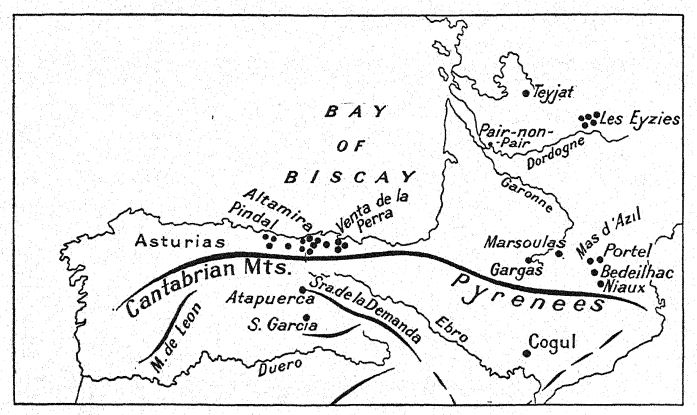
We are far from 1880, observes Cartailhac,21 when the discovery by Sautuola of the paintings on the roof of the cavern of Altamira was met with such scepticism and indifference. Knowing the artistic instincts of the Upper Palaeolithic people from their engraving and carving in bone and ivory, we should have been prepared for the discovery of a parietal art. The publication of the engravings in the grotto of La Mouthe by Riviere^^ in April, 1895, was the first warning of our oversight, and immediately Edouard Piette recalled Altamira to the memory of the workers on prehistoric art. The discovery of Sautuola ceased to be isolated. Led by the engravings found in La Mouthe, [ p. 395 ] [ p. 396 ] Daleau discovered the engravings in the grotto of Pair-non-Pair, Gironde. In 1902 there was the double discovery of the engravings in the grotto of Combarelles, and of the paintings in the grotto of Font-de-Gaume, communicated by Gapitan and Breuil. Discoveries at Marsoulas, Mas d’Azil, La Grèze, Bernifal, and Teyjat soon followed.[4]
| Sculpture | Incised Figures | Painted Figures | |
|---|---|---|---|
| Azilian. | VI. No animal drawings. | VI. Conventional Azilian decoration. Flat pebbles (galets) colored in red and black. Mas d’Azil, Marsoulas, Pindal, | |
| Late Magdalenian. | V. Entirely wanting. | V. No animal art. Various schematic and conventional figures and signs (bands, branches, lines, punctuated surfaces suggesting the Azilian galets). | |
| Middle Magdalenian. | Slender human figurines in ivory and bone. Animal forms in reindeer and stag horn on implements of the chase and ceremonial insignia. |
IV. Graffites feebly traced; fine lines indicating hair predominate in the drawings, as at Font-de-Gaume and Marsoulas, Perfected animal outlines and details. Fine animal outlines, Grotte de la Mairie, Marsoulas. Perfected engraving on bone and ivory. |
IV. Polychrome animal figures with the contour in black and interior modelling obtained through a mingling of yellow, red, and black color. Constant association of r adage and of incisions with painting. siy Usees. Great, brilliant polychrome frescos of Marsoulas, Font-de-Gaume, Altamira. Animal outlines in black, Niaux. |
| Early Magdalenian. | Animal sculpture. Bisonsof fucd’Audoubert; high reliefs of horses, CapBlanc. | III. Deeply incised lines followed by light graffite contour lines. Incised outlines and hair, e. g., mammoths of Combarelles. Striated drawings, Castillo, Altamira, Pasiega. | III. Figures of a flat tint and Chinese shading without modelling, also dotted animal figures as at Fontde-Gaume, Marsoulas, Altamira, Pasiega. |
| Solutrean. | Bone sculpture in high relief; 1st uritx, Pyrenees. Animal sculpture in the round, Pred,ost. | Engravings. | |
| Late Aurignacian. | Heavy human statuettes (id jls) of Mentone, Brassempouy, Wiliendarf, Brünn. Human basreliefs of Laussel. Heavy human fi gurines of Sireuil, Pair-non-Pair. | II. Animal and human figures, at first very deeply incised, then less so; four limbs generally figured. Designs vigorous, somewhat awkward, as at La Mouthe, then more characteristic as at Combarelles. | II. Filling in lines at first feeble, then more and more strong, finally associated wdth contour modelling which ultimately covers the entire silhouette. ^ Incised lines associated with painting as at Combarelles, Fontde-Gaume, La Mouthe, Marsoulas, Altamira. |
| Early Aurignacian. | Animals in low relief. | I. Figures deeply incised, heavy, in absolute profile; stiff in form as at Pair-non-Pair, La Grèze, La Mouthe, Gargas, Bernifal, Hornos de la Peña, Marsoulas, Altamira. Archaic animal outlines of Castilla. |
I. Linear tracings in monochrome, single black or red lines, indicating only a silhouette. Two limbs out of four are ordinarily figured. The most ancient paintings of Castillo, Altamira, Pindal, Font-de-Gaume, M arsoiilas, La Mouthe, Combarelles, Bernifal. |
| Statuary and basrelief. | Mobile and parietal art in line. | Parietal and mobile art in color. |
STAGES IN THE DEVELOPMENT OF UPPER PALAEOLITHIC ART
In 1908 Dechelette listed eight caverns in Dordogne, six in the Pyrenees, and seven along the Cantabrian Pyrenees of northern Spain, but there are now upward of thirty caverns in which traces of parietal art have been found, and doubtless the number will be greatly enlarged by future exploration, because the entrances of many of the grottos have been closed, and the remote recesses in which drawings are placed, as in the recent discovery of Tuc d’Audoubert, are very difficult to explore.
The chief divisions of Upper Palgeolithic art are as follows:
- Drawing, engraving, and etching with fine flint points on surfaces of stone, bone, ivory, and the limestone walls of the caverns.
- Sculpture in low or high relief. Chiefly in stone, bone, and clay.
- Sculpture in the round in stone, ivory, reindeer and stag horn.
- Painting in line, in monochrome tone, and in polychromes of three or four colors, usually accompanied or preceded by line engraving, with flint points or low contour reliefs.
- Conventional ornaments drawn from the repetition of animal or plant forms or the repetition of geometric lines.
¶ Drawings and Engravings op the Early Magdalenian
We have already traced the art of engraving, as it first appears in late Aurignacian times, into the Solutrean ; in the latter it is but feebly represented. Its further development in early Magdalenian times is found in the engravings made with more delicate or more sharply pointed flint implements, capable of drawing an excessively fine line ; these were doubtless the early Magdalenian microliths. The animal outlines, with an indication [ p. 397 ] of hair, are frequently sketched with such exceedingly fine lines as to resemble etchings; the figures are often of very small dimensions and marked by much closer attention to details, such as the eyes, the ears, the hair both of the head and the mane, and the hoofs ; the proportions are also much more exact, so that these engravings become very reahstic. Breuil ascribes to the early Magdalenian the engraved mammoth tracings of Combarelles. Engravings of this period are also found in the grottos of Altamira in Spain, and of Font-de-Gaume in Dordogne, [ p. 398 ] and to this stage belongs the group of does at Altamira, distinguished by the peculiar lines of the hair covering the face. The subjects chosen are chiefly the red deer, reindeer, mammoth, horse, chamois, and bison. The striated drawings of CastHlo and Altamira, which partly represent hair and are partly indications of shading, belong to this period.

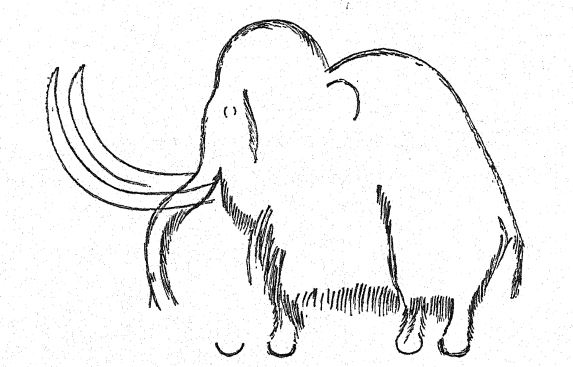
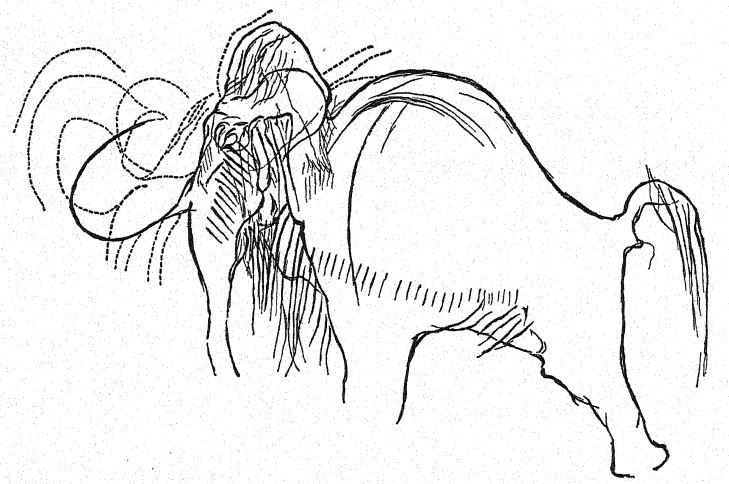

The engravings in the grotto of La Mouthe were discovered by Riviere, in 1895, and were the means of directing attention afresh to the long-forgotten parietal art found in Altamira by Sautuola in 1880. The drawings at La Mouthe begin about 270 feet from the entrance and may be traced for a distance of 100 feet, scattered in various groups; they manifestly belong to a very primitive stage, probably early Magdalenian, the point of chief interest being that, while the greater part of the engravings are in simple incised lines, here and there the contour is enforced by a line of red or black paint ; this is the beginning of [ p. 399 ] a method pursued throughout the Magdalenian parietal art, in which the artist carefully sketches his contours with sharp-pointed flints before he applies any color. This treatment, at first limited to the simple outlines, led to tracing in many of the details with engraved lines, the eyes, the ears, the hair; thus Breuil has shown that in its final development a carefully worked-out engraving underlies the painting. In the La Mouthe drawings the proportions are very bad ; they represent the reindeer, bison, mammoth, horse, ibex, and urus ; spots of red are sometimes splashed on the sides of the animals; here and there is a bit of superior work, such as the reindeer in motion.
The cavern of Combarelles, discovered in 1901, in Dordogne, near Les Eyzies, contains by far the most remarkable record of early Magdalenian art ; there are upward of four hundred drawings and engravings representing almost every animal of early Magdalenian times, among them the horse, rhinoceros, mammoth, reindeer, bison, stag, ibex, lion, and wolf ; there are also between five and six representations of the men of the time, both masked and unmasked ; the style is more recent than that of the oldest drawings in Font-de-Gaume, but much more ancient than the period of polychrome art.[5] The gallery is 720 feet long, and barely 6 feet broad ; the drawings begin about 350 feet from the entrance, and are scattered at irregular [ p. 400 ] intervals to the very end. In general the art is very fine and evidently largely the work of one artist; representations of the woolly rhinoceros and of the mammoth are very true to life; there is a pair of splendid hons, male and female ; the drawings of the horse are abundant, and side by side we have a representation of several types of horses, the pure forest type with the arched forehead, the small, fine-headed Celtic type, and a larger type reminding us of the kiang, or wild ass. Here the greater part of the work is engraving, as contrasted with the painted outhnes in the cavern of Niaux and with the etched outlines of the Grotte de la Mairie.
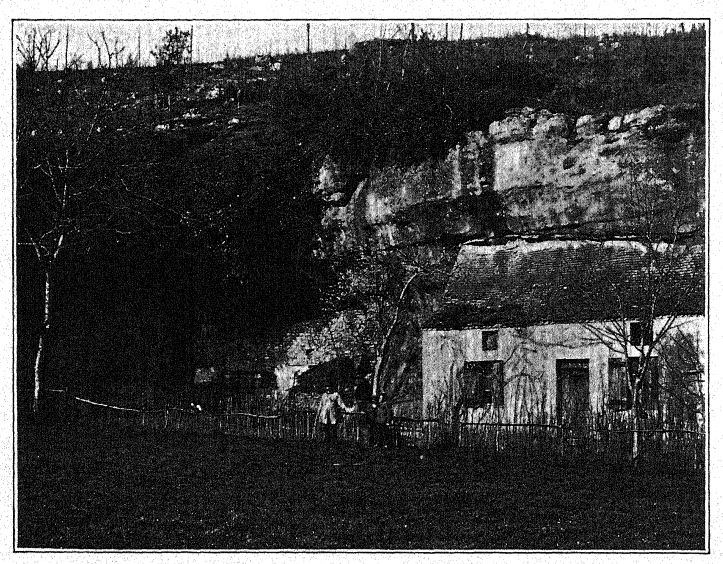
Even a large cavern like Combarelles offers comparatively few surfaces favorable to these engraved lines; but, small or large, such surfaces were eagerly sought, sometimes near the floor, sometimes on the walls, and again on the ceilings; even with [ p. 401 ] the brilliant light of an acetylene lamp it is now difficult to discover all these outlines, some of which are drawn in the most unlooked-for places. If the extremely fine incisions, such ^ as those representing the hair of the mammoth, are so difficult to detect with a powerful illuminant, one may imagine the task of the Crô-Magnon artists with their small stone lamps and wick fed by the melting grease. One such lamp has been found in the grotto of La Mouthe, about 50 feet from the entrance ; the workman’s pick broke it into four pieces, only three of which were recovered. The shallow bowl contained some carbonized matter, an analysis of which led Berthelot, the chemist, to conclude that an animal fat was used for lighting purposes. Like most other implements, this lamp is decorated—in this instance by an engraving [ p. 402 ] of the head and horns of the ibex. Three of these lamps have been found in Charente and Lot, and it is noteworthy that lamps similar to those of the Magdalenian period are used in Dordogne at the present day.
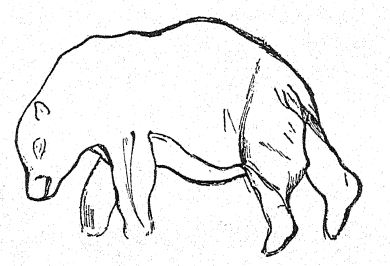
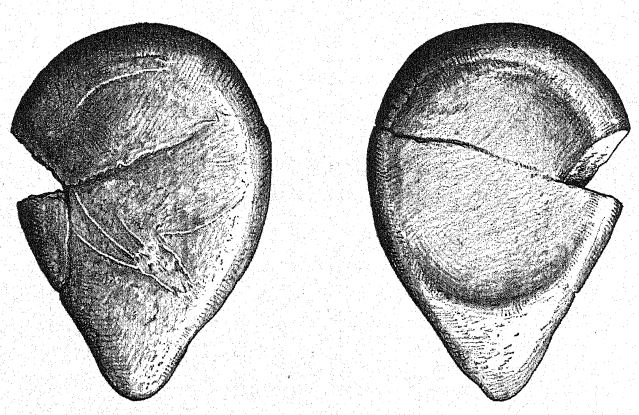
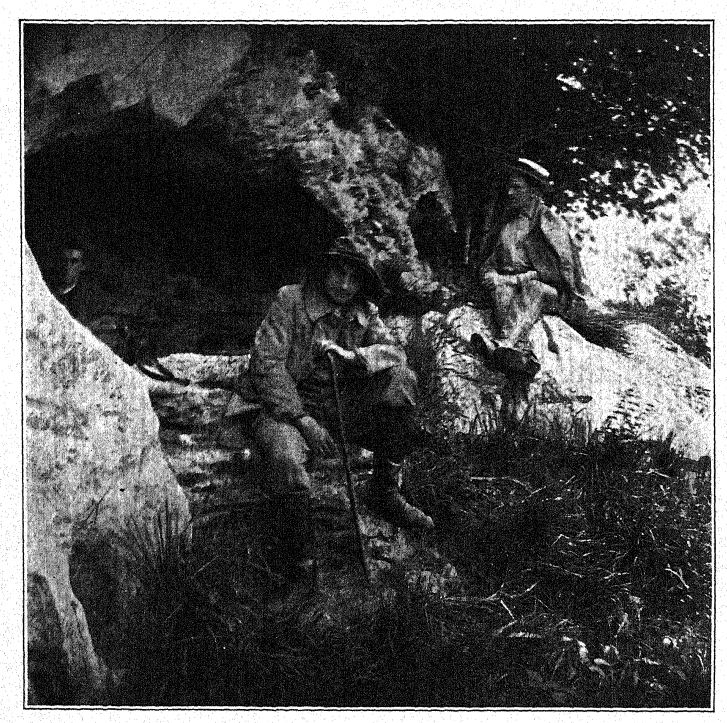

In the great cavern of Castillo,[6] at Puente-Viesgo, discovered in 1903 by Alcalde del Rio, which is entered by the majestic grotto already described on p. 162, the animal drawings are mostly of an archaic character, belonging to the very beginnings [ p. 403 ] of early Aurignacian parietal art. The most abundant subjects are horses and deer, which entirely replace the reindeer drawings so abundant in central France, outlines of the stag and of the doe being very numerous; on the other hand, the bison and the ox are rarely dra-wn. Belonging to the category of most primitive painting are the simple outlines in black of a horse and of a mammoth, the two limbs of one side being represented as inverted triangles, terminating in a sharp point, hke the drawings of children. Of more recent style are the rather crude polychrome bisons, numerous hands outlined in red, and a vast number of tectiform signs and symbols which represent inferior work of the middle Magdalenian period.
On the other side of the same mountain is the grotto of Pasiega, discovered in 1912 by Doctor Hugo Obermaier. This small grotto, about 500 feet above the river, receives its name as a retreat of the shepherds. In the floor is a very narrow opening through which one rapidly descends by means of a tube of hmestone barely large enough to admit the passage of the body. The interior is very labyrinthine. After passing through the Galerie des Animaux and the Galerie des Inscriptions, one reaches, after a most difficult detour, the terminal chamber, which Obermaier has called the Salle du Trône, the throneroom; here there is a natural seat of limestone, with supports at the sides for the arms, and one can still see the discoloration of the rock by the soiled hands of the magicians or of the artists. In this salle there are a few drawings and engravings [ p. 404 ] on the walls, and a few pieces of flint have been discovered. In no other cavern, perhaps, is there a greater sense of mystery as to the influence, whether religious, magical, or artistic, which impelled men to seek out and enter these dangerous passages, the slippery rocks Olumined at best by a very imperfect light, leading to the deep and dangerous recesses below, where a ■misstep would be fatal. The impulse, whatever it may have been, was doubtless very strong, and in this, as in other caverns, almost every surface favorably prepared by the processes of nature has received a drawing. No industrial flints have been found at the entrance to this cavern, but some have been traced into the interior. The art is considered partly of late Aurignacian, perhaps of Solutrean, and certainly in part of early Magdalenian times ; in general it is much more recent than that of Castillo. It consists both of engravings and painted outlines, with proportions usually excellent and sometimes admirable. The paintings of deer are in yellow ochre, of the chamois in red. There are altogether 226 paintings and 36 engravings, in which are represented 50 roe-deer, 51 horses, 47 tectiforms, 16 [ p. 405 ] Bos, 15 bison, 12 stags, 9 ibexes, 1 chamois, and 16 other forms, distributed in all parts of the cave. The outlines are in solid red color or in stripes of red or black, or there is a series of spots ; the subjects are chiefly the stag, the doe, the wild cattle (which are rather common), the bison (which are less common), the ibex, and the chamois. Among the numerous representations of the horse there are two small engravings of a type with erect mane, both the feet and the hair being indicated with great care, the limbs well designed and of excellent proportions, clearly in early Magdalenian style. Of the utmost interest is the discovery here , of two horses drawn with rounded forehead and drooping mane, the only instance in which the drooping mane of the modern type of horse (Equus cahallus) has been observed in the cavern drawings.
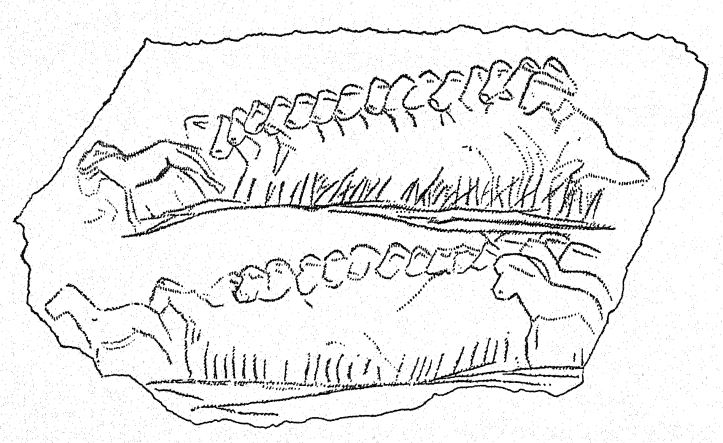

In the advanced development of middle or high Magdalenian art, parietal engraving with finely pointed flint implements presents a nearer approach to the truth both of proportion and of detail than do the earlier stages. In this stage the engravings seem to consist chiefly of independent animal figures and to furnish a prelude to the application of color. A simple but striking example of approaching perfection of technique is seen in the bison (Fig. 205) engraved in the cavern of. Marsoulas, where the profile is outlined and great shaggy masses of hair beneath the neck are. admirably indicated. In these drawings the complicated details of the feet, with their characteristic tufts of hair, and of the head show far more careful observation. In the [ p. 406 ] great series of bison at Font-de-Gaume the entire animal is sketched in with these finely engraved lines, as brought out through the wonderfully close observation and studies of Breuil. This is quite similar to the practice of the modern artist who sketches his figure in crayon or charcoal before applying the color.
There are two quite different styles in this engraving, one seen in the deep incised lines of the reindeer head in the cavern of Tuc d’Audoubert (Fig. 232), a complete design in itself, another seen in the deep incisions in the limestone outlining the horses and the bison as observed in the cavern of Niaux (Fig. 174). Here the engraved line is followed by the application of a black painted line, the effect being to bring out the body in the surrounding rock so as to give the silhouette a high relief.

In the drawings in the large on these curved wall surfaces, only part of which could be seen by the eye at one time, the difficulties of maintaining the proportions were extreme, and one is ever impressed by the boldness and confidence with which the long sweeping strokes of the flint were made, for one rarely if ever sees any evidences of corrected outline. Only a lifelong [ p. 407 ] observer of the fine points which distinguish the different prehistoric breeds of the horse could appreciate the extraordinary skill with which the spirited, aristocratic lines of the Celtic are executed, on the one hand, and, on the other, the plebeian and heavy outlines of the steppe horse. In the best examples of Magdalenian engraving, both parietal and on bone or ivory, one can almost immediately detect the specific type of horse which the artist had before him or in mind, also the season of the year, as indicated by the representation of a summer or winter coat of hair.
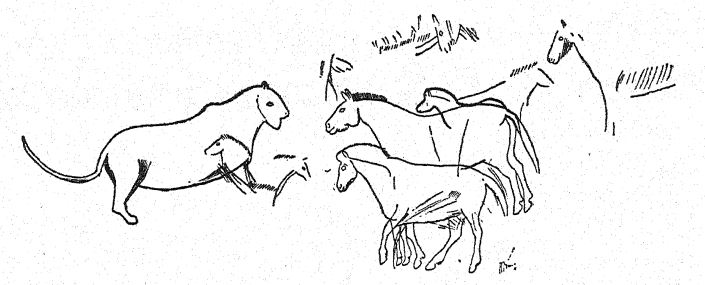
The realism of most of the parietal art passes into the impressionism of the excessively fine engravings on bone or reindeer horn, executed with a few strokes, of a herd of horses or of reindeer (Fig. 207), or where a herd of deer is seen (Fig. 208) crossing a stream full of fishes, as in the well-known engravings on reindeer horn foimd in the grotto of Lorthet, in the Pyrenees. This is one of the very rare instances in Palaeolithic art, either engraving or painting, which shows a sense of composition or the treatment of a subject or incident involving more than one figure. Others are the herd of passing reindeer found engraved on a bit of schist in the grotto of Laugerie Basse, the lion facing a group of horses engraved on a stalagmite at Font-de-Gaume, and the procession of mammoths engraved upon a procession of bison in the same cavern.
[ p. 408 ]
¶ Beginnings of Painting
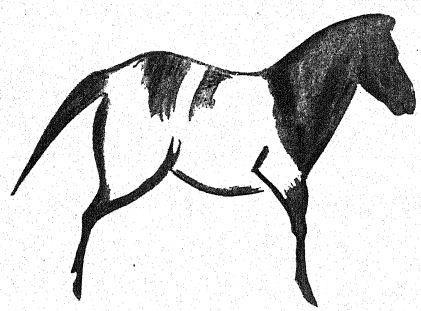
The beginnings of painting in Aurignacian times, consisting of simple contours and crude outlines in red or black, with little or no attempt at shading, pass in early Magdalenian time24 into a long phase of monochromes, either in black or red, in which the technique pursues a number of variations, from simple linear treatment, continuous or dotted, to half tints or full tints, gradually encroaching on the sides of the body from the linear contour. Gf this order are the figures in flat tints and shading, resembling those of the Chinese, without modelling; also the figures entirely covered with dots, such as are seen at Marsoulas, Font-de-Gaume, and Altamira. The tints, as in the drawing of the galloping steppe horse, pass inward from the black outline [ p. 409 ] to enhance the effect of roundness or relief. In the splendid series of paintings in the cavern of Niaux there is little more than the black outline of the body, but the covering of the sides with lines, indicating the hair, lends itself to the rounded presentation of form. A somewhat similar effect is sought in the lines of the woolly rhinoceros painted in red in the cavern of Font-de-Gaume, which Breuil attributes to the Aurignacian stage, but which also suggests the early Magdalenian.
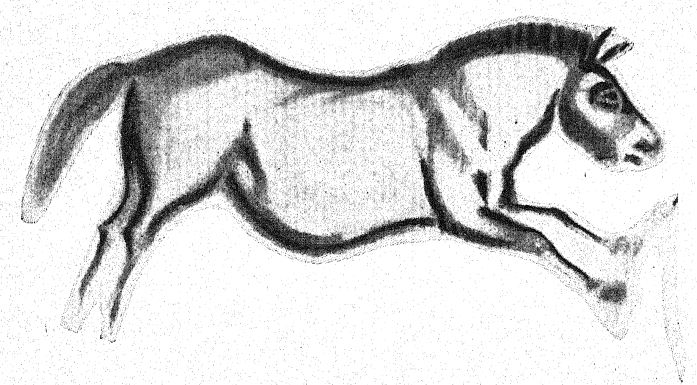
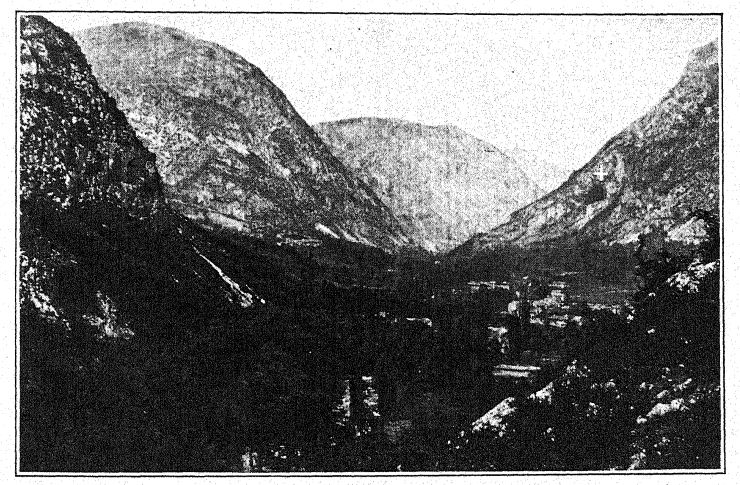
¶ Drawings in Various Caverns of the Early and Middle Magdalenian
The grandest cavern thus far discovered in France is that of Niaux (1906), which from a small opening on the side of a limestone mountain and 300 feet above the River Vic de Sos extends almost horizontally 4,200 feet into the heart of the mountain.25 Not far from Tarascon on the Ariege it lay near one of the most accessible routes between France and Spain. Passing through the long gallery beyond the borders of the subterranean lake which bars the entrance, at a distance of half a mile we reach a [ p. 410 ] great chamber where the overhanging walls of limestone have been finely polished by the sands and gravels transported by the subglacial streams; on these broad, slightly concave panels of a very fight ochre color are drawings of a large number of bison and of horses, as fresh and brilliant as if they were the work of yesterday; the outlines drawn with black oxide of manganese and grease on the smooth stone resemble coarse lithography. The animals are drawn in splendid, bold contours, with no cross-hatching, but with solid masses of bright color here and there ; the bison, as the most admired animal of the chase, is drawn majestically with a superb crest, the muzzle most perfectly outlined, the horns indicated by single fines only, the eyes with the defiant expression highly distinctive of the animal when wounded or enraged. Here for the first time are revealed the early Magdalenian methods of hunting the bison, for upon their flanks are clearly traced one or more arrow or spear heads with the shafts still attached ; the most positive proof of the use of the arrow is the apparent termination of the wooden shaft in the feathers which are rudely represented in three of the drawings. There are also many silhouettes of horses which strongly resemble the pure Asiatic steppe type now living in the desert of Gobi, the Przewalski horse, with erect mane and with no drooping forelock ; in contrast to the bison, the eyes are rather dull and stupid in expression. There are also drawings [ p. 411 ] of other types of horses, a very fine ibex, a chamois, a few outlines of wild cattle, and a very fine one of the royal stag ; we find no reindeer or mammoth represented. In some of the narrower passages the rock has been beautifully sculptured by water, and the artists have been quick to take advantage of any natural lines to add a bit of color here or there and thus bring out the outline of a bison.
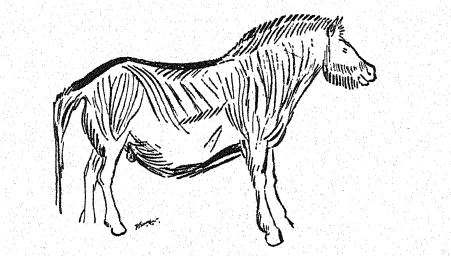
Presenting the widest possible contrast to Niaux is the cavern of Le Portel, west of Tarascon, with its contracted entrance and a very rapidly descending passage hardly broad enough to admit the body. This narrow and tortuous cave terminates in an extremely [ p. 412 ] small passage, so narrow as barely to admit the athletic and determined artist explorer, the Abbé Breuil. Here, as in Font-de-Gaume and other caverns, is one of the greatest mysteries of the cave art, namely, that these terminal and dangerous diverticules finals were wrought with some of the most careful and artistic designs. Le Portel, like Niaux, reveals a single style, but one altogether different. Very numerous bison are drawn in outline both in red and black; the sides of the body are often dotted with red or hatched in close parallel lines. On a long horizontal panel are seen many bison in red, and one observes here a finely dra-wn pair of bison feet in the best Magdalenian style. The horse as represented here is of a quite different type with thin upper tail and a tail-tuft resembling that of the wild ass, so that one is almost tempted to believe that the kiang is intended, but the ears are too short ; it has a high rump and a high, splendidly arched neck, like that of the stallion, and the eye is better drawn ; the body is covered with long vertical or oblique lines which might be mistaken for stripes, but this hatching is a matter of technique only. Again, the mane is erect, and there is no forelock; in fact, none of these Magdalenian artists has represented the horse with the forelock, indicating that this character [ p. 413 ] of the modern horse was unknown in western Europe and probably came in during Neolithic times.
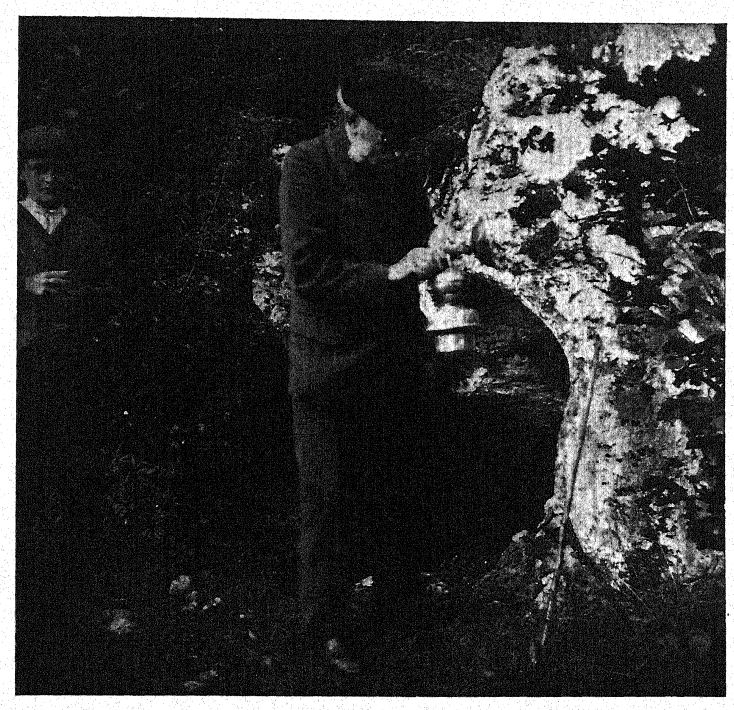
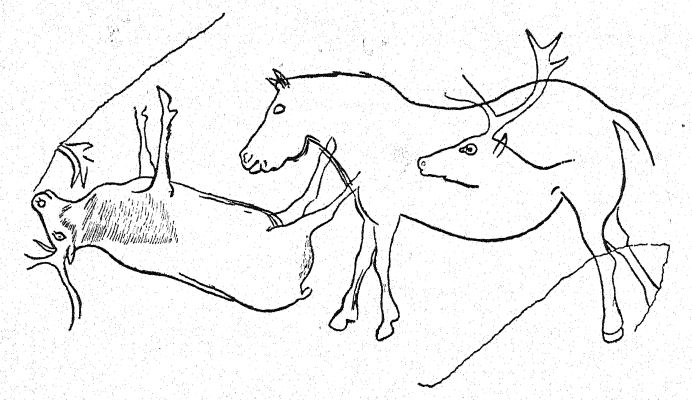
Of an entirely different type are the beautifully engraved miniature figures of animals discovered in 1903 in the Grotte de la Mairie.26 The outlines, from 18 to 20 inches in length, are sharply engraved on the limestone stalagmites; they are all in the middle Magdalenian style and include the stag, reindeer. bison, cave-bear, lion, wild cattle, and two very distinct types of horses: one of these types is large-headed with an arched forehead; this is probably the forest type and perhaps represents [ p. 414 ] the horse most abundant at the Solutre encampment (see p. 288) ; the other horse is small-headed, with a perfectly, flat, straight forehead, corresponding with the Arab or Celtic pony type.
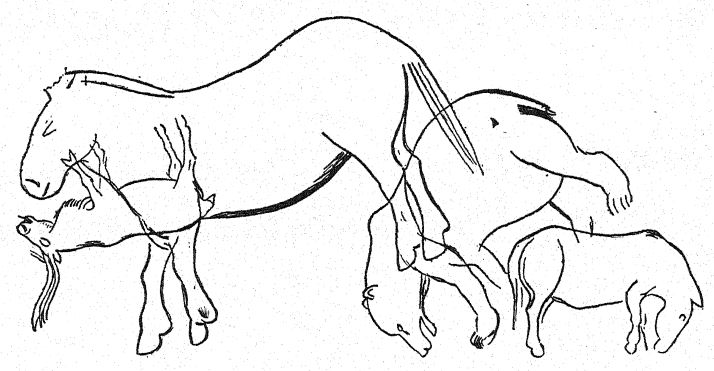
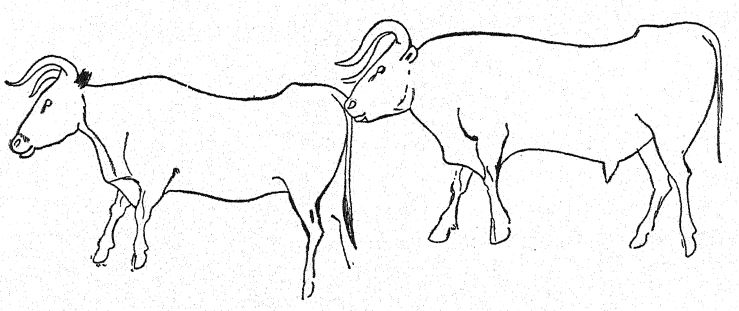
¶ Drawings and Paintings of the End of the Middle Magdalenian
The fourth and final developmental phase of painting flowers out toward the end of middle Magdalenian times in the grand period of polychromes. These are first etched with underlying lines engraved with flint, the surface of the limestone having been previously prepared by the thinning or scraping of the borders (raclage) to heighten the relief of the drawing; then a very strong contour is laid down in black, and this may be followed by a further contour line in red (the use of black and red is very ancient); an ochreous brown color is mixed in, conforming well with what we know to be the tints of the hairy portions of the bison. Thus gradually a complete polychrome fresco art develops. The final stage of this art follows, in which the filling out of various tones of color requires the use of black, brown, red, and yellowish shades. The underlying or preliminary engraving now begins to recede, being retained only for the tracing in of the final details of the hair, the eyes, the horns, and the hoofs. [ p. 415 ] The early stages of this art are seen in the cavern of Marsoulas. and its height is reached in the mural frescos of Font-de-Gaume and in the ceiling of Altamira, the latter still in a perfect and brilliant state of preservation.
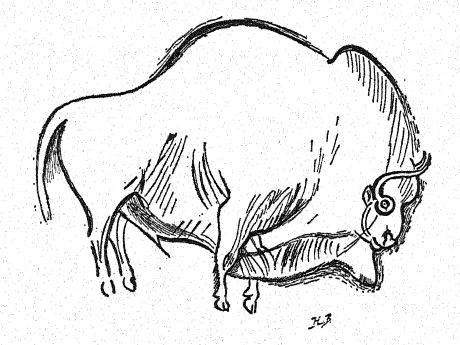
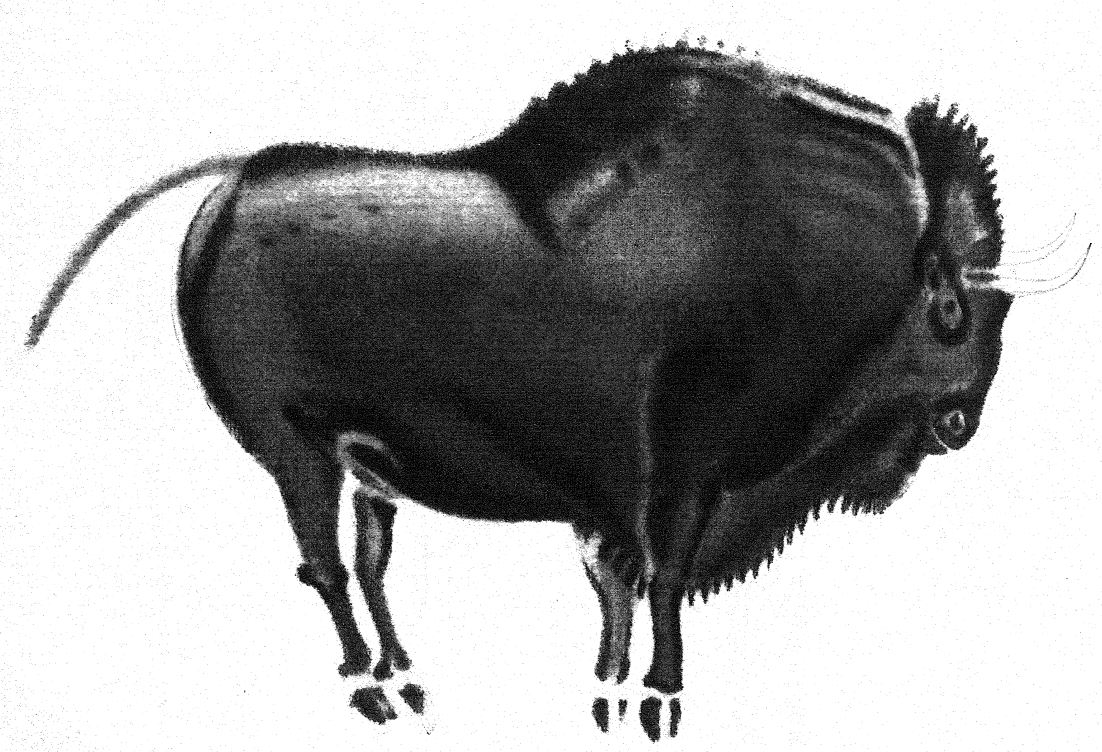
To prepare the colors, ochre and oxide of manganese were ground down to a fine powder in stone mortars; raw pigment was carried in ornamented cases made from the lower-limb bones of the reindeer, and such tubes still containing the ochre have been found in the Magdalenian hearths ; the mingling of the finely ground powder with the animal oils or fats that were used was probably done on the fiat side of the shoulder-blade of the reindeer or on some other palette. The pigment was quite permanent, and in the darkness of the Altamira grotto it has been so perfectly preserved that the colors are still as brilliant as if they had been applied yesterday.
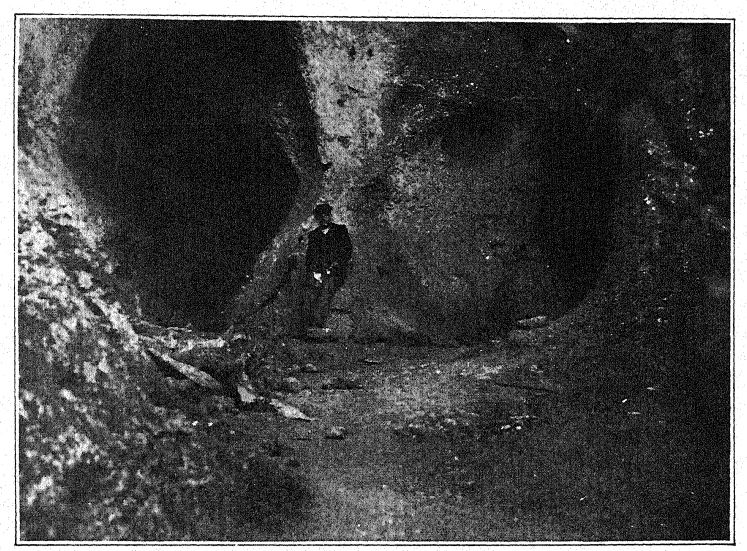
The art of the grotto of Idhrsoulas, in the Pyrenees, is both [ p. 416 ] of an earlier and of a later period; the engraved lines, as of the head and front of a bison, are beautifully done in advanced Magdalenian style, deep incisions representing the larger outlines and finer incisions representing the hair ; here the outlines are also traced in color, and there are several masks or grotesques of the human face ; these last are treated with a total disregard of the truth which characterizes the animal work. Among the few bison represented here, some are covered with dots or splashes of color, others show the painted outline which begins to extend over the surface with gradations of tint, anticipating the color effects attained in the finished paintings of Altamira and Font-de-Gaume. All the details of the early technique are found here: the artist outlines the form with an engraved line; the traces in black color the contours of the head and of the body; he begins to apply masses of red over the figure. This beginning of polychrome art at Marsoulas is a step toward coloring the entire surface with red ochre and black, as in the finished paintings of a later period.
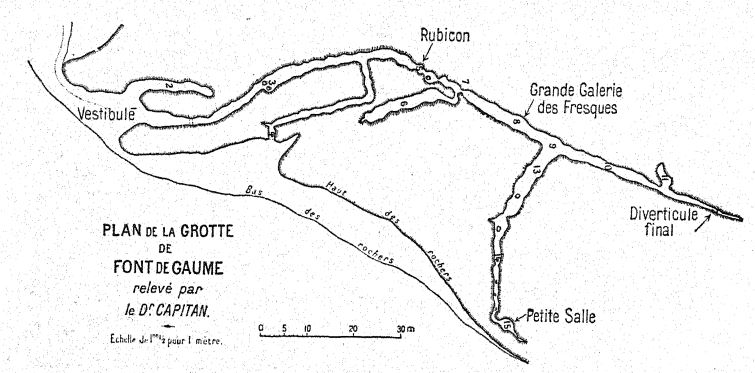
The grand cavern of Font-de-Gaume,27 on the Beune, not far from. Les Eyzies, contains the most complete record of Upper Palaeolithic art, especially from the close of Aurignacian to the [ p. 417 ] [ p. 418 ] [ p. 419 ] close of Magdalenian times. There are crude Aurignacian drawings, simple outlines painted in black, outlines supplemented by the indication of hair (examples of the early stages in the development of polychrome work as well as of the very highest stages), compositions like the lion and the group of horses, and the murals in the Galerie des Fresques, which show a general composition in the processions of animals, as well as some special compositions such as the reindeer and bison facing each other. The life depicted is largely that of the tundras, mammoths, rhinoceroses, and reindeer, but it also includes the steppe or Celtic type of horse, represented galloping (Fig. 211), and a small group of horses of the Arab or Celtic type. Of the meadow fauna the bison is generally represented in preference to the wild ox or urus.
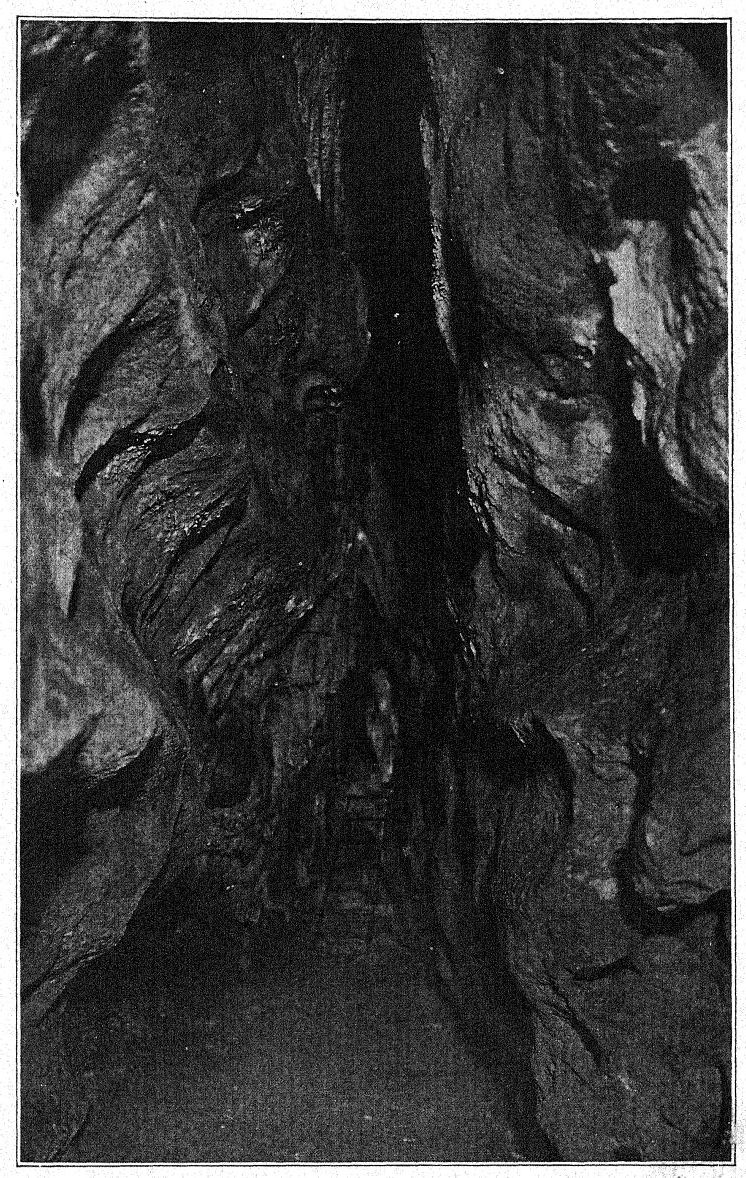
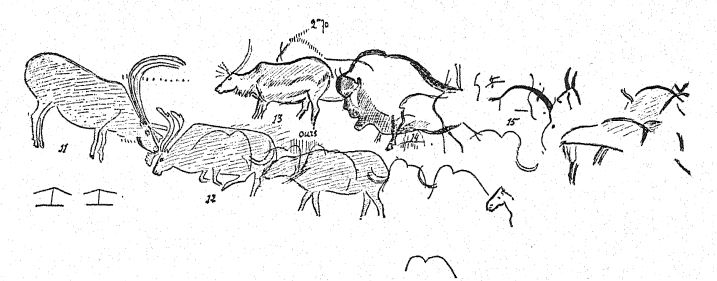
Throughout the cavern the favorable surfaces of the walls are crowded with engravings, and in the Galerie des Fresques, beyond the narrow passage known as the ‘Rubicon’ (Fig. 221), we see altogether the finest examples of Upper PalieoHthic art. On each side of this gallery is a peculiarly advantageous mural surface, broad, relatively smooth, and gently concave (Pl. VII), probably the best which any cavern afforded, and here we observe great processions of mammals superposed upon each other, like the records of a palimpsest, as if such a surface was so rare that it was visited again and again. The most imposing series is that of the bison, done in the finest polychrome style, mostly [ p. 420 ] headed in one direction. The reindeer form another series and in some instances face each other, although mainly arranged in a long procession facing to the left. This superposition of drawing upon drawing ends with the latest superposition in finely incised lines of a great procession of mammoths upon that of the polychrome bisons. It is somewhat difficult to reconcile a religious or votive interpretation with the multiphcation of these drawings upon each other. Moreover, it appears to be inconsistent with the reverent spirit which pervades the work in this and in all other caverns, for what impresses one most is the absence of trivial work or meaningless drawings.

It seems as if at every stage in their artistic development these people were intensely serious about their work, each drawing being executed with the utmost possible care, according to the degree of artistic development and appreciation.
In the great gallery of frescos we find not less than eighty [ p. 421 ] figures, in some cases partly covered by a fine sheen of stalagmitic limestone ; these include 49 bison, 4 reindeer, 4 horses, and 15 mammoths. The bison polychromes have suffered somewhat in color and are far less brilliant than those at Altamira. In the polychromes the color is applied either in long lines of red or black surrounding the contours of the animal or in flat tints placed side by side, or again the two colors are mingled and give intermediate tints with striking effect. On one of the finest of these bison is the underlying drawing of a reindeer, a wild boar, and the superposition of an excellent engraving of a mammoth, which is represented on an altogether different scale, so that it falls well within the body lines of the bison (Fig. 224). In each of these mammoths the grotesque but truthful contour is preserved in the drapery of hair which almost completely envelops the limbs; the emphasizing of the sudden depression of the dorsal line behind the head is everywhere the same and undoubtedly conforms very closely to nature.
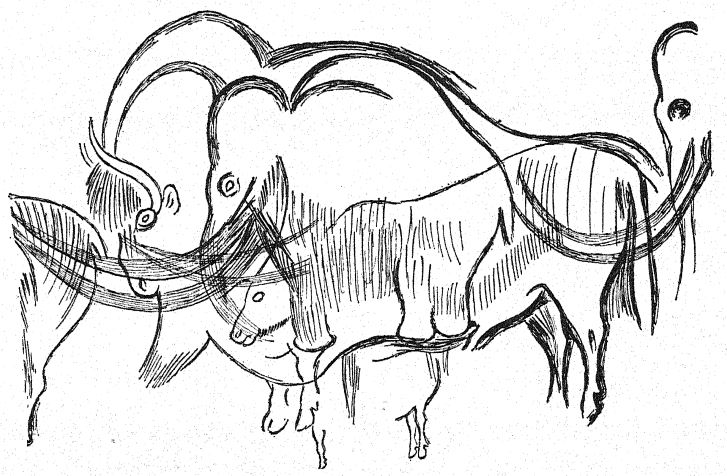
[ p. 422 ]
After passing the Galerie des Fresques we penetrate to the final recess called the Diverticule final, through excessively narrow tubular openings barely admitting the body, and we are again overcome with the mystery as to what impulse carried this art mto the dark, deep portions of the caverns. If it were due [ p. 423 ] to a feeling partly religious whicli regarded the caverns with special awe, why do we find equally skilful and conscientious work on all the mobile utensils of daily life and of the chase, apart from the caverns ? The superposition of one drawing upon another, which is especially characteristic of this cavern, does not seem to strengthen the religious interpretation.
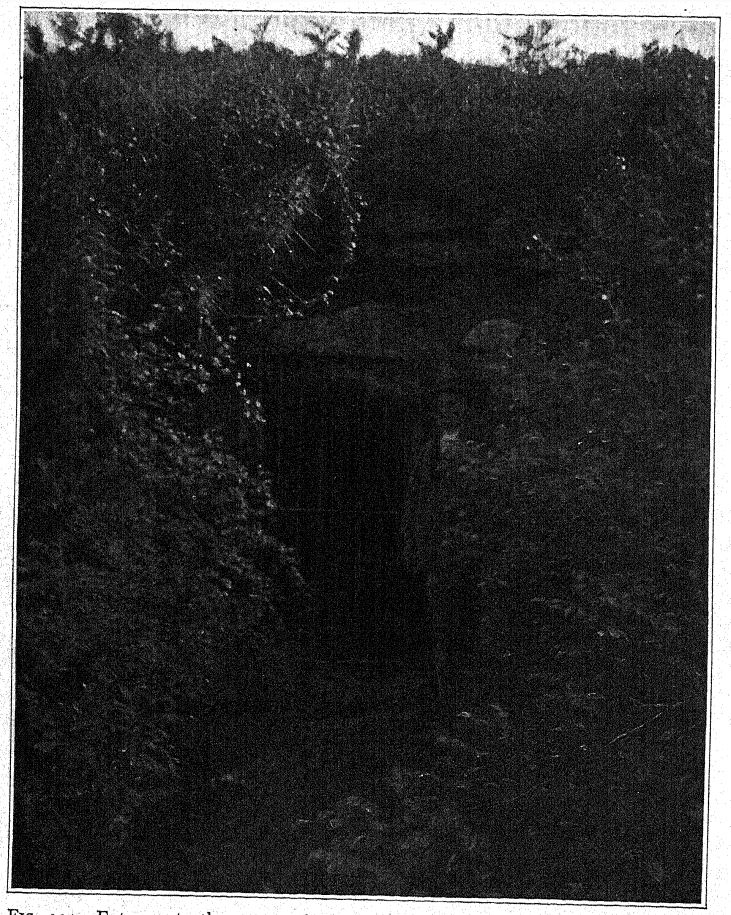
It would appear that the love of art for art’s sake, akin in a very rudimentary form to that which inspired the early Greeks, together with the fine spaces which these caverns alone afforded for larger representations, may be an alternative explanation. There is no evidence that numbers of people entered these caverns. If this had been the case there would be many more examples of inartistic work upon the walls. It is possible that the Crô-Magnon artists constituted a recognized class especially gifted by nature, quite distinct from the magician class or the artisan class. The dark recesses of the caverns opening back of the grottos may have been held in awe as mysterious abodes. In line with this theory is the suggestion that the artists may have been invited into the caverns by the priests or medicinemen to decorate the walls with all the animals of the chase.
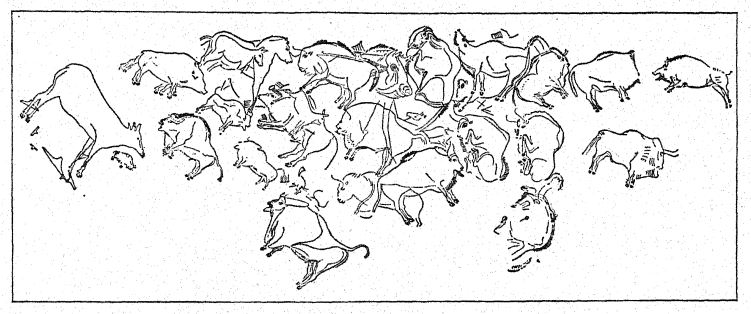
The polychromes of the ceiling of Altamira in northern Spain, which rank in the crude art of Palaeolithic times much as the ceiling of the Sistine Chapel does in modern art, are somewhat [ p. 424 ] more conventional in technique than those of Font-de-Gaume, but they are manifestly the work of the same school, and prove that the technique of art spread like that of engraving, of sculpture, and of the preparation of flint and bone implements all over southwestern Europe. One could not have more striking proof of the unity of race, of a conamunity of life, and of an interchange of ideas among these nomadic people than the close resemblance which is observed in the art of Altamira, Spain, and that of Font-de-Gaume, 290 miles distant, in Dordogne.
Very picturesque is the account of the discovery of this wonderful ceiling, made not by the Spanish archaeologist Sautuola himself, but by his little daughter, who, while he was searching for flints on the floor of the cavern, was the first to perceive the paintings on the ceiling and to insist upon his raising his lamp aloft. This was in 1879, long before the discovery of parietal art in France. The ceiling is broad and low, within easy reach of the hand, and the oval bosses of limestone (Fig. 227), from [ p. 425 ] 4 to 5 feet in length, and from 3 to 4 in width, led to the development here of one of the most striking characteristics of all PalaeoUthic art, namely, the artist’s adaptation of the subject to his medium and to the character of the surface upon which he was working. It seems to show a high order of creative genius that each of these projecting bosses was chosen for the representation of a bison lying down, with the limbs drawn up in different positions beneath the body (Fig. 228) and very carefully designed. and with the tail or the horns alone projecting beyond the convex surface to the surrounding plane surface. This is the only instance known where the bison are represented as lying down, in most lifelike attitudes, showing the soles of the hoof, observed with the greatest care and represented by a few strong and significant lines. Thus while the Altamira coloring inclines to conventionality, the pose of these animals indicates the greatest freedom of style and mastery of perspective anywhere observed. In this wonderful group there is also a bison bellowing, with his back arched and his limbs drawn under him as if to expel the air. One striking feature in all these paintings is the vivid representation [ p. 426 ] of the eye, which in every case is given a fierce and defiant character, so distinctive of the bison bull when enraged. We also observe a wild boar in a running attitude and several spirited representations of the horse and of the female deer. The cavern of Altamira, besides this chef-d’ceuvre, contains work of a very advanced character, as indicated in the imposing engraidng of the royal stag (Fig. 229), which is altogether the finest representation of this animal which has thus far been discovered in any cavern.
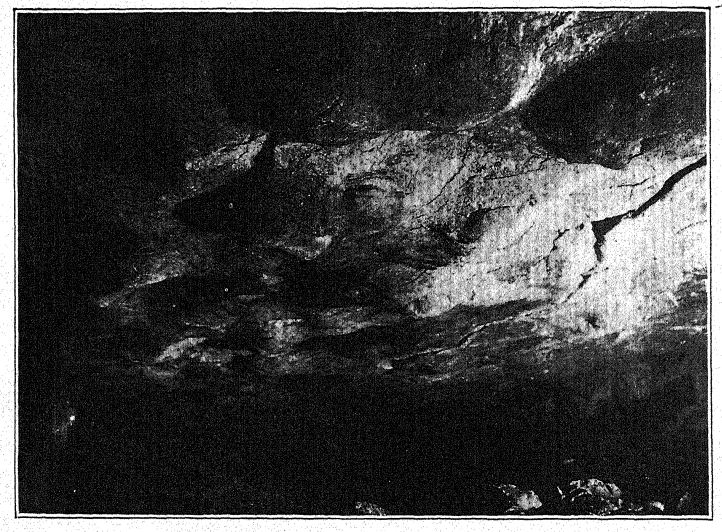
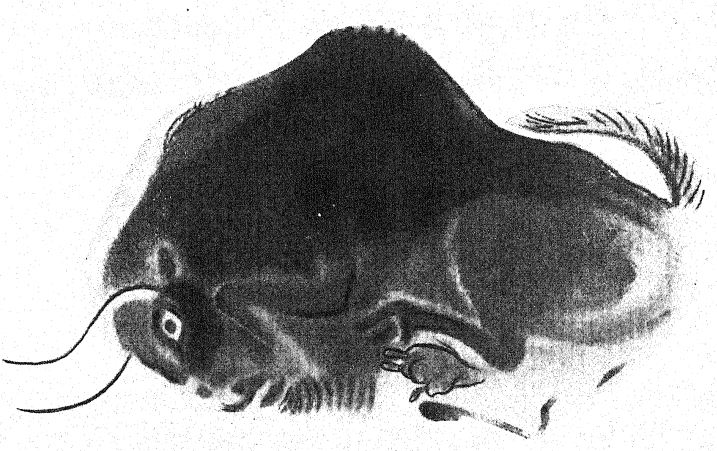

Altamira, like Font-de-Gaume, presents many phases of the development of art in Magdalenian times. There is a Solutrean layer in the foyer of this great cavern, but Breuil is not inclined to attribute any of the art to this period. The first entrance of Altamira by the Crô-Magnon artists is dated by the discovery of engravings on bone of the female red deer, which are identical [ p. 427 ] with those on the walls and which belong to very ancient Magdalenian times, the period at which the caverns of Castillo and La Pasiega were also entered.28
¶ Sculpture
Animal sculpture in the round, which is indicated by the few statuettes found with the burial at Brünn, Moravia, and by the ivory mammoth statuette found at Predmost, continued into early Magdalenian times and certainly constitutes one of the most distinctive features of the art of that period, because in the later Magdalenian it took a different trend in the direction of decorative sculpture. Only two fine examples of early Magdalenian animal sculpture have been found, but these are of such a remarkable character as to indicate that modelling in the round was widely pursued at this time. These are the bisons discovered in 1912 in the cavern of Tuc d’Audoubert near Montesquieu, [ p. 428 ] in the Pyrenees, and the fine bas-reliefs of horses at the shelter of Cap-Blanc, on the Beune, in Dordogne.
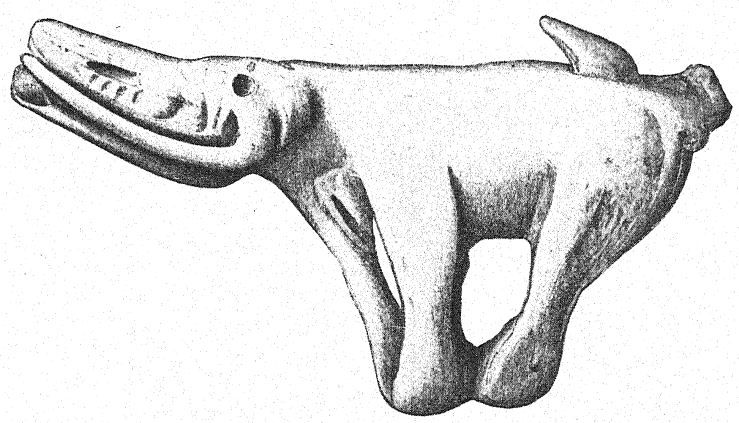
In company with Professor Cartailhac the writer had the good fortune to enter the cavern of Tuc d’Audoubert a few days after its discovery by the Comte de Begouen and his sons ; it is still in the making, for out from the entrance flows a stream of water large enough to float a small boat, by which the first of a series of superbly crystallized galleries is reached. After passing through a labyrinth of passageways and chambers a favorable surface was found where the Begouen party showed us a whole wall covered with low-engraving reliefs, very simply done, fine in execution, with sure and firm outlines of the bison, the favorite subject as in all other caverns ; horses fairly well executed and of tne same steppe type as those in the near-by cavern of [ p. 429 ] Niaux; one superbly engraved contour of the reindeer, with its long, curved horns; the head of a stag with its horns still in the velvet ; and a mammoth. All this work is engraved ; there are no drawn outlines, but here and there are splashes of red and black color. Shortly afterward a great discovery was made in this cavern ; it is described as follows by the Comte de Begouen:[7] “To-day I am happy to give you excellent news from the cavern Tuc d’Audoubert. As you were the first to visit [ p. 430 ] this cavern, you will also be the first to learn that in an upper gallery, very difficult of access, at the srunmit of a very narrow ascending passage, and after having been obliged to break a number of stalactites which completely closed the entrance, my son and myself have found two superb statuettes in clay, about 6o cm. in length, absolutely unbroken, and representing bison. Cartailhac and Breuil, who have come to see them, were filled with enthusiasm. The ground of these chambers was covered with imprints of the claws of the bear, skeletons of which were buried here and there. The Magdalenians have passed through this ossuary and have drawn out all the canine teeth to make ornaments of them. Their steps left their fine impressions on the humid and soft clay, and we still see the outlines of several bare hrunan feet. They had also lost several flakes of flint and the tooth of an ox pierced at the neck ; we have collected them. [ p. 431 ] and it seems as if they had only dropped yesterday ; the Magdalenians also left an incomplete model of a bison and some lumps of kneaded clay which still carry the impression of their fingers. We produce the proof that in this period all branches of art were cultivated.” This model of the male and female bison in clay has been described by Cartailhac as of perfect workmanship and of ideal art.
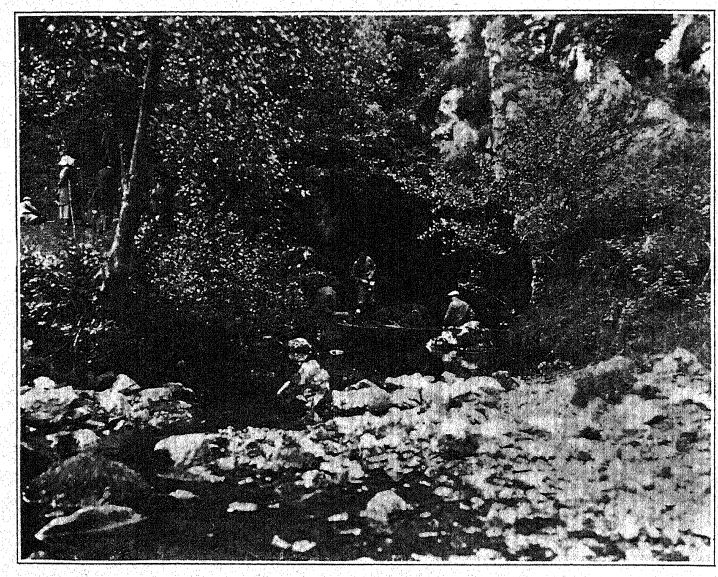
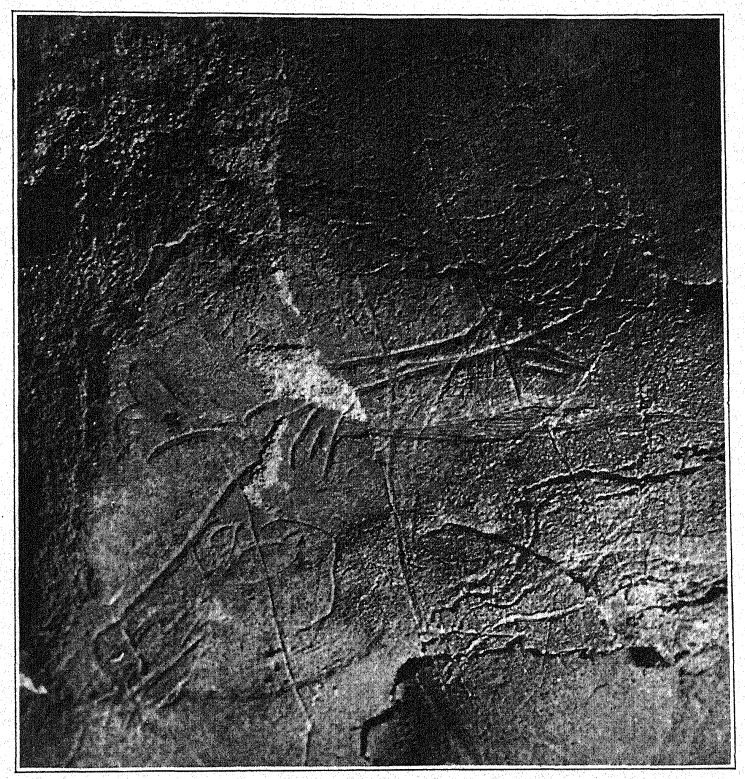
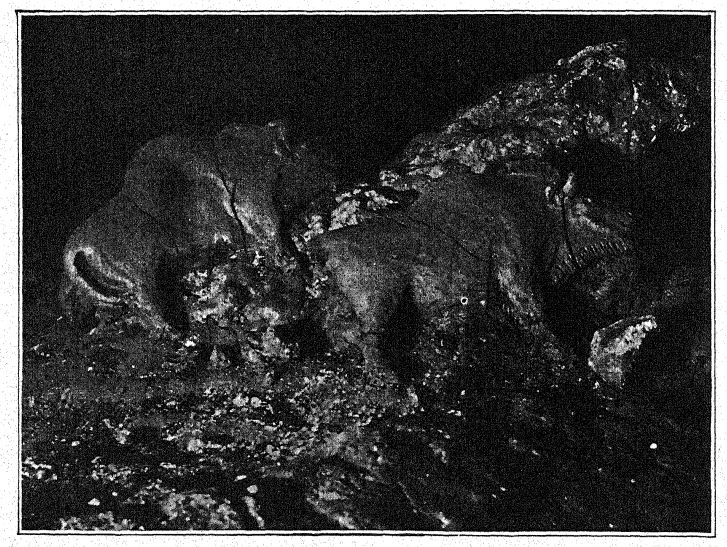
The procession of six horses cut in limestone imder the sheltering cliff of Cap-Blanc is by far the most imposing work of Magdalenian art that has been discovered. The sculptures are in high relief and of large size and are in excellent proportion ; they appear to represent the high-bred type of desert or Celtic horse, related to the Arabian, so far as we can judge from the long, straight face, the slender nose, the small nostrils, and the massive angle of the lower jaw; the ears are rather long and pointed, and the tail is represented as thin and without hair ; they were found partly buried by layers containing implements of middle Magdalenian industry, and they are therefore assigned to an early Magdalenian date in which animal sculpture in the round reached its climax.
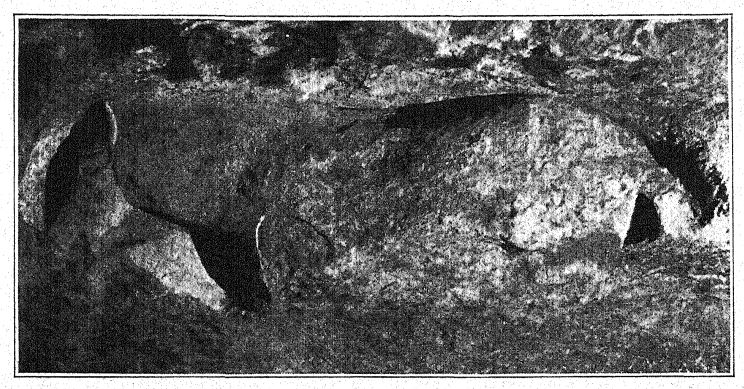
[ p. 432 ]
From the early to the middle Magdalenian period animal sculpture in bone, horn, and ivory was followed as decorative art in a bold and highly naturalistic manner. Adaptation of the animal figure to the surface and to the material employed is nowhere shown in a more remarkable way than in the bâtons, the dartthrowers, and the poniards. Of all the work of the Upper Palaeolithic, these decorative heads and bodies are, perhaps, the [ p. 433 ] most highly artistic creations in the modern sense. The famous horse foimd in the late Magdalenian levels of Mas d’Azil (Fig. 235) and the small horses from the grotto of Espelugues, of the middle Magdalenian, are full of movement and life and show such certainty and breadth of treatment that they must be regarded as the masterpieces of Upper Palaeolithic gl3^tic art. The ibex carved on the dart- thrower from the grotto of Mas d’AzU (Fig. 178) indicates observation and a striking power of expression; while all the details are noted, the treatment is very broad.

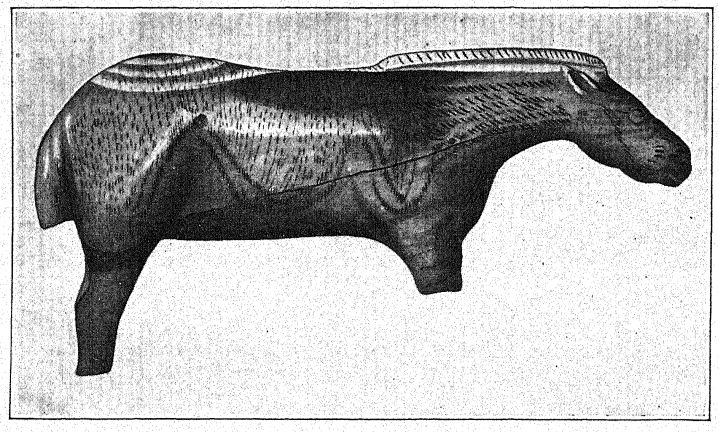
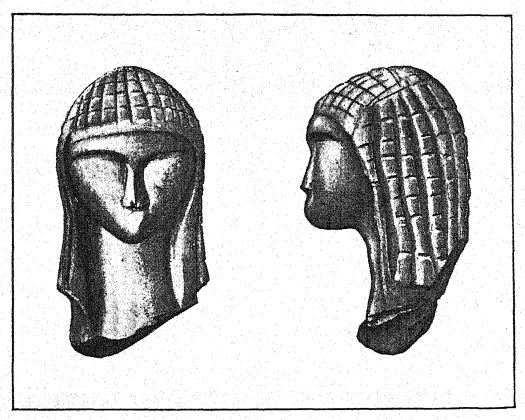
The continuation of animal sculpture in the round is seen in the well-known horse statuette from the grotto of Lourdes; the partly decorative striping is a step in the direction of conventional treatment. The sculptured reindeer discovered by Begouen in the grotto of Enlene is treated in a somewhat similar style.
Small human figurines again appear in the form of statuettes in bone or ivory, representing the renaissance of the spirit of human sculpture. Some of this work is apparently in search of beauty and with altogether different motives from the repellent feminine statuettes of middle and late Aurignacian times, for [ p. 434 ] the subjects are slender and the limbs are modelled with relative skill. As in the earlier works, there is a partial failure to portray the features, which is in striking contrast to the lifelike treatment of animal heads. Very few examples of this work have been found, and most of them have been broken. To this period belong the Venus statuette of Laugerie Basse and the head of a girl carved in ivory found at Brassempouy (Fig. 237) with the features fairly suggested and an elaborate head-dress.
¶ Geographic Distribution of the Magdalenian Culture
In Magdalenian times the Crô-Magnon race undoubtedly reached its highest development and its widest geographic distribution, but it would be a mistake to infer that the boundaries of the Magdalenian culture also mark the extreme migration points of this nomadic people, because the industries and inventions may well have spread far beyond the areas actually inhabited by the race itself.
Absence of Magdalenian influence around the northerly coasts of the Mediterranean is certainly one of the most surprising facts. Breuil has suggested that Italy remained in an Aurignacian stage of development throughout Magdalenian times and indicates that there is much evidence that Magdalenian culture never penetrated into this peninsula, for in Italy the Aurignacian industrial stage is succeeded by traces of the Azilian. This geographic gap, however, may be filled at any time by a fresh discovery. In Spain, also, the Magdalenian culture is known only in the Cantabrian Mountains, but never farther south, one of the earliest sites found in this region being the grotto of Peña la Miel, visited by Lartet in 1865, and one of the most famous the cavern of Altamira, discovered by Sautuola in 1875 ; to the northeast is the station of Banyolas. So far the eastern provinces of Spain have not yielded any implements of engraved or sculptured bone.
In contrast to this failure to reach southward, the Magdalenian culture is widely extended through France, Belgium, England, [ p. 435 ] Germany, Switzerland, Austria, and as far east as Russia. It would appear either that the men of Magdalenian times wandered far and wide or that there was an extensive system of barter, because the discovery of shells brought for personal adornment from the Mediterranean seashores to various Magdalenian sites in France and in central Europe seems to indicate a wide-spread intercourse among these nomadic hunters and a system of trade reaching from the coasts of the Mediterranean and the Atlantic to the valley of the Neckar in Germany and along the Danube in Lower Austria. Another proof of this intercourse is the wide distribution not only of similar forms of implements but of very similar decorations ; as an instance, Breuil notes the likeness of schematic engravings on reindeer horn in [ p. 436 ] the two primitive Magdalenian layers of Placard, Charente, to those found in the Polish cavern of Maszycka, near Ojcow, and to others in the corresponding layers of Castillo, near Santander, of Solutre on the Sadne, and of various sites in Dordogne. A very distinctive geometric decoration on bone is that of broken zigzag lines with little intercalated transverse lines, which we notice at Altamira, in northern Spain, and which also occurs here and there in Dordogne and in Charente and extends to the grottos of d’Arlay in the Jura. Another style of ornament, with deep pectinate and punctuate lines, found in the very ancient Magdalenian of Placard, also occurs in the most ancient layers of Kesslerloch, Switzerland. Spiral ornaments like those on the bone weapons of Dordogne, of Arudy, and of Lourdes are found at Hornos de la Peña, in the Cantabrian Mountains. The spread of analogous decoration is still more striking when we find it occurring in the details of sculpture or in a certain type of dartthrower (propulseur) , which extended from the Pyrenees eastward to the Lake of Constance. Inventions like that of the harpoon and fashions like those of the decorative motifs were carried from point to point.
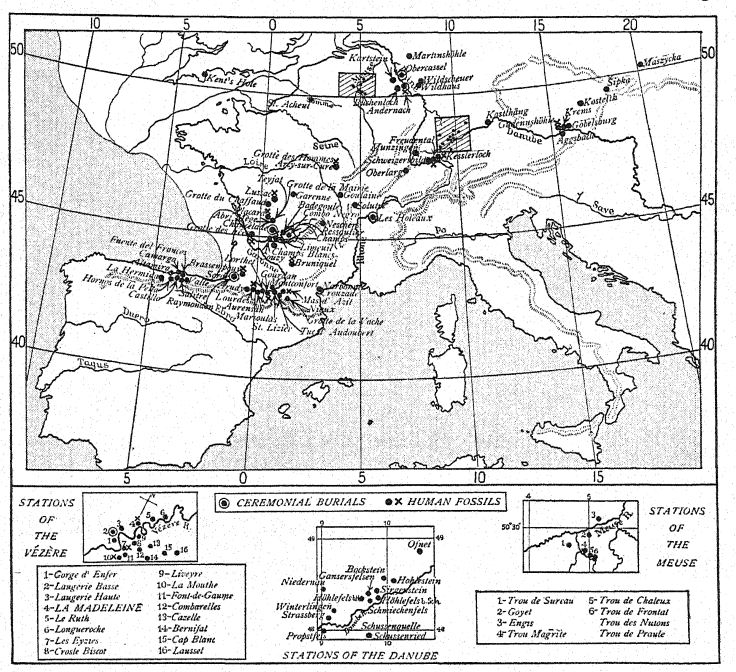
This influence does not lead to identity. Some of the phases of art and of decoration are confined to certain localities; for example, the engravings of deer on the bone shoulder-blades in the caverns near Santander, Spain, are not duplicated in France ; also there are numerous local styles witnessed in the forms and decorations of the javelin, the lance, and the harpoon ; these variations, however, do not conceal the element of community of culture and of similar fluctuations of industry and art between widely distant stations.
Many Magdalenian stations were crowded around the sheltered cliffs of Dordogne (Fig. 238). Besides these, we observe the Magdalenian sites of Champs, Ressaulier, and the grotto of Combo-Negro in Correze; south of Dordogne and Correze are other stations along the Garonne and the Adour. Some of the fines examples of Magdalenian art have come from Bruniquel, on Aveyron, near the boundary between Tarn-et-Garonne [ p. 437 ] and Tarn, where no less than four important sites have been excavated.
The culture map of France in Magdalenian times is covered from north to south with these ancient camp sites, either clustered along the river borders, where erosion has created shelters, or in the great outcrops of limestone along the northern slopes of the Pyrenees, where the exposure of the limestone has led to the formation of grottos and caverns, or on the plateaus where game abounded or flint could be found for the rapidly declining flint industry. Near the Gulf of Lyons are the stations of Rise, Tournal, Narbonne, and Crouzade ; extending westward toward the headwaters of the Ariege are La Vache, Massat, and the great tunnel station of Mas d’Azil, formed by the River Arièze here the Magdalenian levels discovered by Piette have yielded some [ p. 438 ] of the most notable Magdalenian works of art, including animal statuettes, bas-reliefs, and, engravings with incised contours.
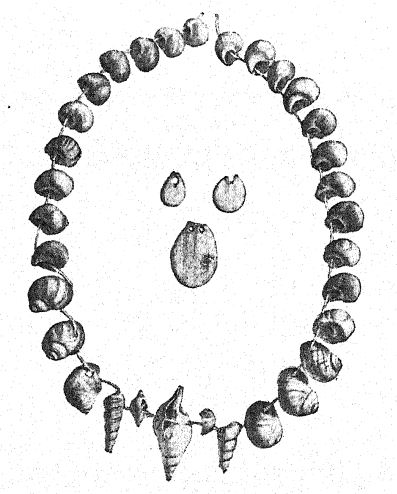
Farther west, on the headwaters of the Garonne, is Gourdan, where Piette began his remarkable excavations in 1871 and discovered two of the ancient Magdalenian phases of sculpture ; then comes the more westerly group of Aurensan, Lorthet, and Lourdes, the latter a grotto which has yielded one of the finest examples of the horse sculptured in ivory, and which has since become famous as the site of a miracle and of modern pilgrimage. Between the Garonne and the Bay of Biscay lie the stations of Duruthy and the Grotte du Pape of Brassempouy, the latter occupied in Magdalenian times, but best known as a centre of late Aurignacian sculpture of statuettes.
To the northeast, in the very heart of the mountainous region of Auvergne, is the station of Neschers, where a flow of lava from Mount Tartaret descended over the slopes of Mont-Dore and covered a Mousterian industrial deposit with its mammoth fauna and then, after a lapse of time, became the site of a Magdalenian industrial camp, so that Boule has been able to determine the geologic age of the most recent volcanic eruptions in France, those of the Monts d’Auvergne, as having occurred between the periods of Mousterian and Magdalenian industry.
In view of the frequent occurrence of Aurignacian and Solutrean camps as well as of Neolithic stations in southeastern France, we are surprised at the extreme rarity there of Magdalenian flint implements. However, Capitan has recognized a Magdalenian station at Solutré, near the headwaters of the Saone, and not far from this site is the station of Goulaine, which has yielded an enormous flint scraper or anvil, the largest Upper Palaeolithic implement ever found; it is carefully chipped around the entire curved edge and weighs over 4 ¼ pounds. To the north of the Dordogne is the celebrated grotto of Placard, in Charente, where the dawn of the Magdalenian industry has been discovered, and again directly north of this is the grotto of Chaffaud, at Savigne, where the first engraved bone of the ‘Reindeer Age’ was discovered in 1834; not far from this is the shelter [ p. 439 ] [ p. 440 ] of Garenne, near St. Mareel (Indre), which has afforded a fine figure of a galloping reindeer.
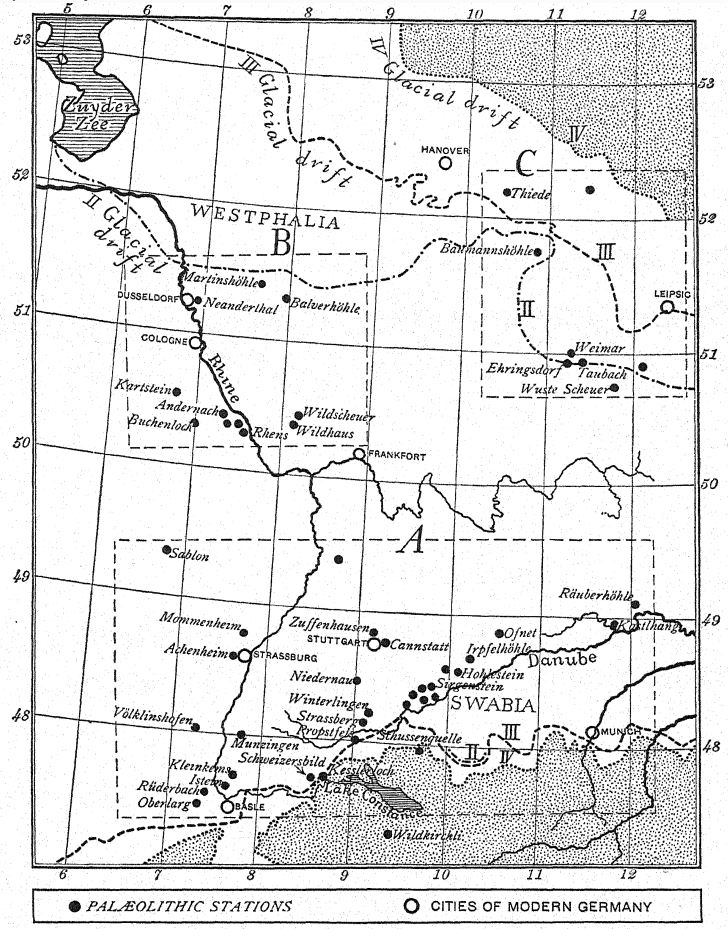
These geographic and artistic records are of intense interest as carrying the Perigord or Dordogne culture northward. Somewhat to the east, on the headwaters of the Cure, a tributary of the Yonne, there is an important group including over sixty open shelters formed in the Jurassic limestone, in which characteristic Magdalenian bone implements have been found. Of these the most famous are the Grotte des Fees, and the Grotte du Trilobite, both of which were first entered by the Neanderthals in Mousterian times and were again sought by the Crô-Magnons in Magdalenian times. Passing still farther north, the Crô-Magnons visited the borders of the Somme and sought the historic flint station of St. Acheul, which had been frequented by races of men for thousands of years previous, back to Pre-Chellean times.
To the northeast are the stations of Belgium, chiefly made known through the labors of Dupont, distributed along the valleys of the Lesse and of the Meuse and yielding characteristic Magdalenian flints as well as a number of engravings on bone. We may be sure that this region was under Crô-Magnon rule and that their control extended over into Britain, where, it will be recalled, a Crô-Magnon skeleton was found at Paviland, in western Wales. Here, again, in Magdalenian times the Crô-Magnon race was probably wide-spread over southern Britain. At Bacon’s Hole, near Swansea, Wales, there is a wall decoration consisting of ten red bands, which, according to Breuil and Sollas, may possibly be of Palaeolithic age. More definite is the Magdalenian industry observed at the Cresswell Crags, in Derbyshire ; while near Torquay, Devonshire, is the famous station of Kent’s Hole, discovered in 1824, in which a bone needle has been found and several harpoons with double rows of barbs belonging to the late Magdalenian industry.
In Germany, whereas only three Solutrean stations have been discovered,29 there are no less than fourteen Magdalenian stations to attest the wide spread of that culture. Thus the [ p. 441 ] favorite grotto of Sirgenstein, near the centre of the Magdalenian stations on the upper waters of the Danube, although abandoned in Solutrean times, was again entered by man during the early Magdalenian culture stage. Coincident with the return of man to this great grotto was the arrival of the banded lemming (Myodes torquatus), the herald of the cold tundra wave of life in the far north. At the very same time man with the banded lemming arrived at Schweizersbild, near the Lake of Constance; at a slightly earlier period, with the dawn of Magdalenian culture, man entered the sister station of Kesslerloch. It certainly appears that a cold moist climate accompanying the Bühl advance influenced all the Crô-Magnon peoples of this region just north of the Alpine glaciers and compelled them to seek the grottos and shelters. There are, however, some open stations in this general region, for example, at Schussenried, Wiirttemberg; the Magdalenian culture layer is not found in a grotto, but lies under a deposit of peat mingled with the remains of the reindeer, horse, brown bear, and wolf. Again, among the bestknown [ p. 442 ] sites along the middle Rhine is the open-air station of Andernach. Demonstrating the eastward distribution of the art of engraving on ivory and bone is the presence in Andernach and in the grotto of Wildscheuer, near Steeten, on the Lahn, of engravings of this character. Thus far these are the only German stations in which such engravings have been found.
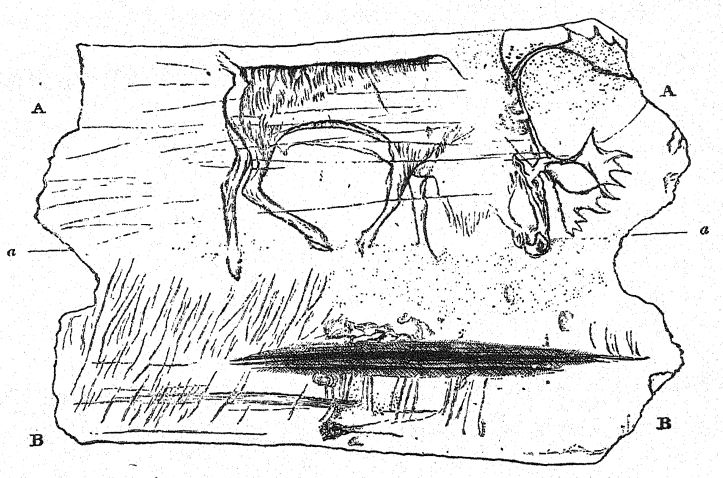
Of especial interest also is the open Magdalendan ‘loess’ station of Munzingen, on the upper Rhine, because it proves that the highest layers of the ‘upper loess,’ corresponding with the dry or steppe period of climate, were contemporaneous with the advanced or late Magdalenian industry, also because this final ‘upper loess’ stage about corresponds with the period when the last of the arctic tundra mammals began to abandon central Europe. It was at this critical geologic time that the late Magdalenian culture began to draw to a close. Kesslerloch, Switzerland, has yielded a considerable number of engravings on bone, including one of the finest examples of a browsing reindeer (Fig. 241), and Schweizersbild also has yielded a considerable number of rather crude engravings.
Frequented in Magdalenian times was that part of the Swabian Jura lying between the headwaters of the Neckar and of the Danube ; along the course of the Danube, from Propstfels, near Beuron, in the southwest, to Ofnet, in the northeast, extend the other stations of Hohlefels bei Hiitten, Schmiechenfels, and Bocksteinhohle.
West of the Danube the industry was carried into the present region of Bavaria, as indicated by the recent discovery of Kastlhang.30 Here, beginning with the early Magdalenian (Gourdanien inférieur of the French school) and extending to the middle or high Magdalenian (Gourdanien superieur), vi& find a complete series of Magdalenian stations ; the middle Magdalenian layer is of exactly the same type as that found in the Abri Megeof Dordogne and in the lower levels of the Grotte de la Mairie ; the same culture stage is again observed in southern Germany in the stations of Schussenquelle and of Hohlefels, and it extends [ p. 443 ] eastward into Austria in the station of Gudenushöhle as well as into several Moravian stations, for example, that of Kostelik.
These facts are of extraordinary interest, for they show that the civilization, such as it was, of the Upper Palaeolithic was very widely extended. This marks an important social characteristic, namely, the readiness and wiUingness to take advantage of every step in hmnan progress, wherever it may have originated. At this point, therefore, it is interesting to compare the Magdalenian industry of Germany with that of France.31 Germany shows the same technical and stylistic tendencies and the same evolutionary direction as France. The mammalian life was, of course, the same in both countries, for in each region the giant types of mammals still survived, and the banded lemming of the arctic appears in the sheltered valleys of the Dordogne as well as in Belgium and in Germany. The vicissitudes of climate were undoubtedly the same; we observe the alternation of cold moist climate in the early Magdalenian along the upper Danube as well as in the early Magdalenian of the type station of La Madeleine, Dordogne, Again, we observe the transition into the dry cold climate in the steppe character of the fauna both along the upper Rhine, at Munzingen, and also beneath the shelter station of La Madeleine, as recorded by Peyrony.
More vital still for this community of industrial culture was the community of race, for at Obercassel we find the same Crô-Magnon type as that discovered beneath the sheltering cliffs of Dordogne. It appears probable that the inventions of the central region of Dordogne travelled eastward when we note the fact that none of the prototypes of early forms of the harpoon which were common in southern France occur in any of the stations of central Europe, but the single-rowed harpoon is characteristic of the middle Magdalenian all over Germany. Other primitive Magdalenian bone implements, such as the bone spear point with the cleft base, the bâtons, and the needles, are also of rare occurrence in the German stations. In late Magdalenian times, however, a complete community of culture is established, for the industry of both countries in flint and bone appears to be very [ p. 444 ] similar ; flint microliths appear in increasing number and variety ; beside tbe small flint flakes with blunted backs, numerous feathershaped flakes of Pre-Tardenoisian type are found, as well as the types of graving flints. Some specialties of French Magdalenian culture did not find their way into Germany; for example, the graver of the ‘parrot-beak’ type has been found in France but has not been traced far eastward. In both countries, however, are found upper Magdalenian chisels of reindeer horn and perfected bone needles, bâtons, and harpoons with double rows of barbs. On the other hand, works of art and decorative designs in horn and bone are almost entirely wanting in German localities, with the exception of the stations of Andernach and Wildscheuer previously mentioned. In late Magdalenian times, both in Germany and France, we find the Eurasiatic forest fauna becoming more abundant.
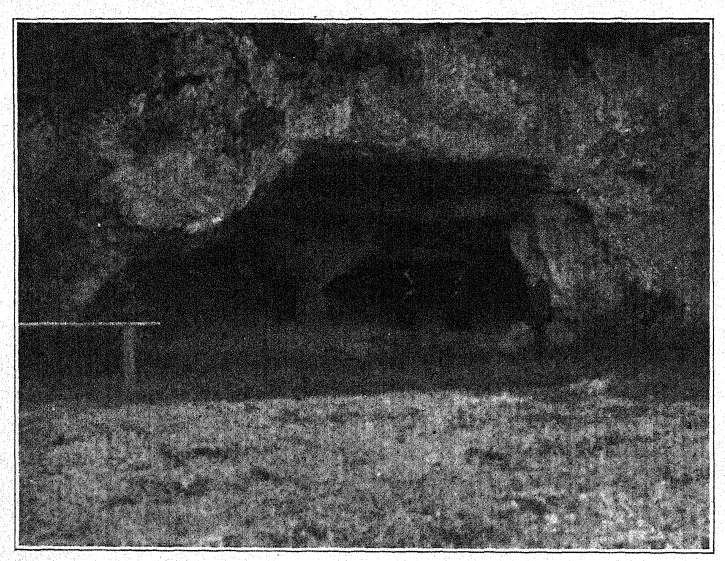
The two famous Swiss stations of Kesslerloch and Schweizers [ p. 445 ] bild, near Lake Constance, appear throughout Magdalenian times to have been in very close touch with the cultural advances of Dordogne. Kesslerloch32 has yielded 12,000 flints of small dimensions, resembling in their succession those of the type station of La Madeleine; also needles, single and double harpoons, dart-throwers, bâtons, as well as the fine engravings mentioned above; bone sculpture is represented here in the unique head of a musk-ox (Ovibos moschatus), in carvings of the reindeer and of other animals on the bâtons and weapons of the chase. Kesslerloch lies on the edge of a moderately wide valley, traversed by a brook ; in this sheltered, well-watered, hilly region, the trees flourished and harbored the forest animals, while the glaciers, retreating and leaving damp and stony areas, were closely [ p. 446 ] followed by the tundra fauna ; the woolly rhinoceros and mammoth persisted here longer than in other parts of Europe; the horse of Kesslerloch is said to show resemblances to the Przewalski horse of the desert of Gobi, in central Asia, and is consequently referred to the steppe type. The development of the flints takes place step by step with that of the sister cavern of Schweizersbild, and in early Magdalenian times these flints are found associated with the arrival of the great migration of the arctic tundra rodents, the banded lemmings (Myodes torquatus). A hearth with ashes and coals and many charred bones of old and young mammals, including the woolly rhinoceros, has been found here ; the animal life altogether includes twenty-five species of mammals, among them the woolly mammoth, woolly rhinoceros, reindeer, and lion.
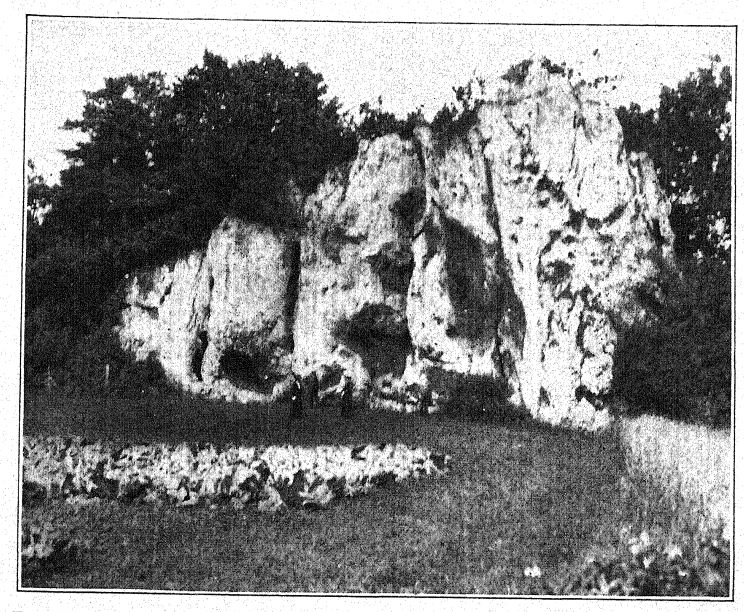
Less than four miles distant from Kesslerloch, in a small valley about two miles north of Schaffhausen, is the other famous Swiss station of Schweizersbild. The Crô-Magnons were attracted to this spot by the protecting cliff of isolated limestone rock rising sheer from the meadow-land, at the base of which is a shelter facing southwest, "with an entrance of about 30 feet in height, commanding a wide view of the distant valley. In the accumulations at the base of this shelter we find a complete prehistory of the human, industrial, faunal, and climatic changes of this region of Switzerland from early Magdalenian into Neolithic times. It was not until the true early Magdalenian, after both the Aurignacian and Solutrean stages had closed, that man first found his way here during the Bühl advance, the period of the deposition of the Upper Rodent Layer with its cold arctic and steppe fauna but from this time the grotto was occupied at intervals until full Neolithic times. The beginning of these industrial deposits is estimated by Nüesch as having occurred between 24,000 and 29,000 years ago, but we have adopted a somewhat lower and more conservative estimate. In descending order the various layers of this shelter, as studied by Nüesch, are as follows :
[ p. 447 ]
Section OF the Schweizersbild Deposits
Neolithic
6. Layer of humous earth, between 15 and 19 inches in thickness, containing Neolithic implements.
5. Gray culture layer, about 15 inches in thickness, including many firehearths, ornaments of shell, polished Neolithic flints, and unglazed pottery. The true forest fauna includes the brown bear, badger, marten, wolf, fox, beaver, hare, squirrel, short-horned wild ox (Bos taurus brachyceros) , and reindeer, also the domesticated goat and sheep.
Upper Palaeolithic
4. Thin layer of forest-living rodents, principally squirrels. Split bones and worked flints ; no carvings in bone or horn; industry of late Magdalenian or close of Magdalenian Upper Palaeolithic age; evidences that climate was changing, steppe conditions passing away, and forests becoming more dominant; only a few steppe species; the forest species include the reindeer, hare, pika, squirrel, ermine, and marten.
3. Yellow culture layer, steppe period, rich in fire-hearths and yielding 14,000 flints of middle [? and late] Magdalenian age; engravings on reindeer antlers, ornaments of shells and teeth. Mixed fauna with steppe and forest types predominant; of the few tundra forms, reindeer very abundant and also arctic fox, but banded lemming and other tundra types entirely lacking; steppe and desert fauna includes the Kang, Persian maral deer, Pallas’s cat (Felis manul), steppe horse, and steppe suslik ; of alpine type, the ibex ; numerous forest species, pine marten, beaver, squirrel, red deer, roe-deer, and wild boar.
2. Arctic tundra rodent layer, 20 inches in thickness ; period of the Bühl Postglacial advance; the banded lemming (Myodes torquatus) most abundant, mingled with early Magdalenian flint and bone implements ; one fire-hearth; abundant tundra fauna, including all tundra types except the Obi lemming, and the musk-ox (Ovibos moschatus) which is found in Kesslerloch; indications of a very cold, moist climate; the banded lemming, arctic fox, arctic hare, reindeer, wolverene, ermine, also such forest forms as the wolf, fox, bear, weasel, and a number of northern birds.
1. Gravel bed and old river deposit, recognized by Boule as belonging to the moraines of the fourth glaciation.
This wonderful deposit of human artifacts and animal remains gives us a complete registration of the changes of climate in this region accompanying the changes of culture and the development of the Magdalenian race.
[ p. 448 ]
Turning our survey to the course of the Danube, we note that several Magdalenian stations extend into the provinces of Lower Austria, chief among them being both the open Toess’ station of Aggsbach, and that of Gobelsburg; there is also the Hundssteig near Krems, better known as the station of Krems, and the cavern known as the Gudenushöhle ; in the latter station the characteristic bâtons, javelins, and bone needles have been found.[8]
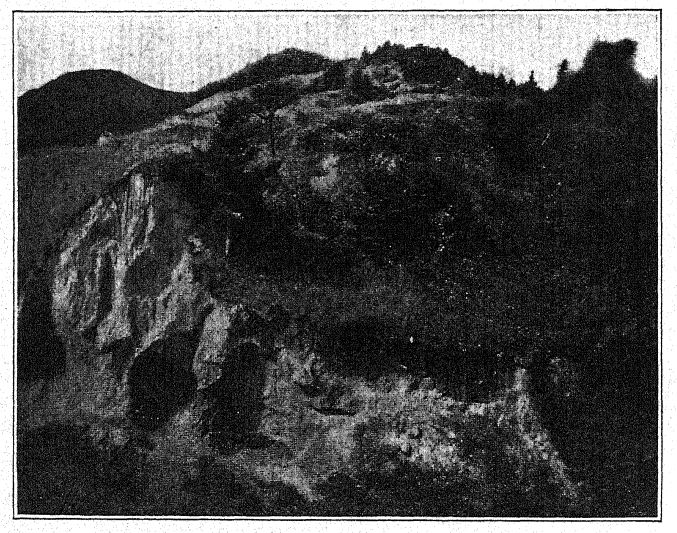
The cavern district of Moravia attracted a relatively large population, and among the numerous stations are the grottos of Kriz, Zitny, Kostelfk, Byciskala, Schoschuwka, Balcarovaskala, Kulna, and Lautsch. Near the Russian border bone implements like those of Gudenushöhle on the Danube have been found at the station of Kulna, and the industrial stratification of [ p. 449 ] Sipka is very clear. Not far from Cracow, across the Russian border, the caverns in the region of Ojcow were entered by men carrying the Magdalenian culture. Another site in Russia is the grotto of Maszycka, and characteristic Magdalenian harpoons, needles, and bâtons de commandement with other implements have also been found to the eastward, in the neighborhood of Kiev, in the Ukraine.
¶ Decline of the Magdalenian Culture

The highest point touched by the Crô-Magnon race in the middle or high Magdalenian appears to correspond broadly with the cold arid period of climate in the interval between the Bühl and Gschnitz advances in the Alpine region, during which the steppe mammals spread widely over southwestern Europe.
The saiga antelope, for example, a highly characteristic steppe type, is represented in one of the most skilful bone carvings found in the late Magdalenian layers of Mas d’Azil; also the steppe type of horse is frequently represented in the most advanced engravings of late Magdalerdan times. How far this cold, relatively dry climate influenced the artistic and creative energy of the Crô-Magnons is largely a matter of conjecture. The entirely independent records of La Madeleine, of Schweizersbild, and of Kesslerloch concur in associating the highest stage of Magdalenian history of art with the predominance of the steppe fauna and evidences of a cold dry climate. That the mammoth still abounded is seen in the mammoth engravings which are superposed on those of the bison in Font-de-Gaume.
The succeeding life period is that of the retreat of the tundra [ p. 450 ] and steppe mammals and of the increasing rarity of the reindeer and of the mammoth in southwestern Europe; it corresponds broadly with the returning cold and moist climate of the second Postglacial advance known in the Alps as the Gschnitz stage. With the spread of the forests and the retreat to the north of the reindeer, the principal source both of the supply of food and clothing and of all the bone implements of industry and of the chase, a new set of life conditions may have gradually become established. If it is true, as most students of geographical conditions and of the climate maintain, that Europe at the same time became more densely forested, the chase may have become more difficult, and the Crô-Magnons may have begun to depend more and more upon the life of the streams and the art of fishing. It is generally agreed that the harpoons were chiefly used for fishing and that many of the microlithic flints, which now begin to appear more abundantly, may have been attached to a shaft for the same purpose. We know that similar microliths were used as arrow points in predynastic Egypt.
Breuil35 observes very significant industrial changes in clos ing Magdalenian times : first, the beginning of small geometric forms of flints suggesting the Tardenoisian types; second, the occasional use of stag horn in place of reindeer horn; third, a modiftcation in the form of bone implements toward the patterns of Azilian times ; fourth, the rapid decline — one may almost say sudden disappearance — of the artistic spirit. Schematic and conventional designs begin to take the place of the free realistic art of the middle Magdalenian.
Thus the decline of the Crô-Magnons as a powerful race may have been due partly to environmental causes and the abandonment of their vigorous nomadic mode of life, or it may be that they had reached the end of a long cycle of psychic development, which we have traced from the beginning of Aurignacian times. We know as a parallel that in the history of many civilized races a period of great artistic and industrial development may be followed by a period of stagnation and decline -without any apparent environmental causes.
[ p. 451 ]
¶ Gro-Magnon Descendants in Modern Europe
We might attribute this great change, which affected all of western Europe, to the extinction of the Crô-Magnon race were it not for the existing evidence that the race survived throughout the Azihan-Tardenoisian or close of the Upper Palaeolithic. On the close of the Palaeolithic the race broke up throughout western Europe into many colonies, which can perhaps be traced into Neolithic and even into recent times. The anatomical evidence for this survival theory chiefly consists of the highly characteristic form of the head.
In Europe a very broad face and a long, narrow cranium is such an infrequent combination that anthropologists maintain that it affords a means of identifying the descendants of the prehistoric Crô-Magnon race wherever they persist to-day. Since Dordogne was the geographic centre of the race in Upper Palaeolithic times, is it merely a coincidence that Dordogne is still the centre of a similar type? Ripley^® has given us a valuable resume of our present knowledge of this subject. The most significant trait of the long-headed people of Dordogne is that in many cases the face is almost as broad as in the normal Alpine round-headed type; in other words, it is strongly disharmonic ; in profile the back part of the head rises and in front view the head is narrowed at the top ; the skull is very low- vaulted ; the brow ridges are prominent ; the nose is well formed ; the cheekbones are prominent, and the powerful cheek muscles give a peculiarly rugged cast to the countenance. The appearance, however, is not repellent, but more often open and kindly. The men are of medium height, but very susceptible to environment as regards stature ; they are tail in fertile places, and stunted in less prosperous districts. They are not degenerate at all, but keen and alert of mind. The present people of Dordogne agree with but one other type of men known to anthropologists, namely, the ancient Crô-Magnon race. The geographical evidence that here in Dordogne we have to do with the survivors of the real Crô-Magnon race seems to be sustained by a comparison of the [ p. 452 ] characteristics of the prehistoric skulls found at Crô-Magnon, Laugerie Basse, and elsewhere in Dordogne, with the heads of the types of to-day. The cranial indices of the prehistoric skulls, varying from 70 per cent to 73 per cent, correspond with indices of the living head of 72 per cent to 75 per cent. None of the people of Dordogne are quite so long-headed as this, the average index of the living head in an extreme district being 76 per cent ; but within the whole population there are much lower indices.
The probability of direct descent becomes stronger when we consider the disharmonic low-skulled shape of the Crô-Magnon head and the remarkable elongation of the skull at the back. In the prehistoric Crô-Magnons the brows were strongly developed, the eye orbits low, the chin prominent. The facial type has been characterized by de Quatrefages37 as follows; “The eye depressed beneath the orbital vault ; the nose straight rather than arched; the lips somewhat thick, the jaw and the cheekbones strongly developed, the complexion very brown, the hair very dark and growing low on the forehead — a whole which, without being attractive, was in no way repulsive.”
In southern France we observe a continuity not only of the head form but of the prevalence of black hair and eyes. Why should this Crô-Magnon type have survived at this point and have disappeared elsewhere ? In order to consider the particular cause of this persistence of a Palaeolithic race, we must, with Ripley, broaden our horizon, and consider the whole southwest from the Mediterranean to Brittany as a unit.
The survival is partly attributed to favorable geographical environment and partly to geological and racial barriers. On the north the intrusion of the Teutonic race was shut off and competition was narrowed down to the Crô-Magnon and Alpine types.
If the people of Dordogne are veritable survivors of the Crô-Magnons of the Upper Palaeolithic, they certainly represent the oldest living race in western Europe, and is it not extremely significant that the most primitive language in Europe, that of [ p. 453 ] the Basques of the northern. Pyrenees, is spoken near by, only 200 miles to the southwest? Is there possibly a connection between the original language of the Cr 6 -Magnons, a race which orice crowded the region of the Cantabrian Mountains and the Pyrenees, and the existing agglutinative language of the Basques, which is totally different from all the European tongues? This hypothesis, suggested by Ripley,38 is very well worth considering, for it is not inconceivable that the ancestors of the Basques conquered the Crô-Magnons and subsequently acquired their language.
The prehistoric Crô-Magnon men would seem, therefore, to have remained in or near their early settlements through all the changes of time and the vicissitudes of history. “It is, perhaps,” observes Ripley, “the most striking instance known of a persistency of population unchanged through thousands of years.”
The geographic extension of this race was once very much wider than it is to-day. The classical skull of Engis, Belgium, belongs to this type. It has been traced from Alsace in the east to the Atlantic in the west. Ranke asserts that it is to be found to-day in the hills of Thuringia, and that it was a prevalent type there in the past. Verneau considers that it was the type prevailing among the extinct Guanches of the Canary Islands. Collignon39 has identified it in northern Africa, and regards the Crô-Magnons as a subvariety of the Mediterranean race, an opinion consistent at least with the archaeological evidence that this race came into Europe with the Aurignacian culture, which was circum-Mediterranean in distribution. Traces of Crô-Magnon head formation are found among the living Berbers.
At present, however, this race is believed to survive only in a few isolated localities, namely^ in Dordogne, at a small spot in Landes, near the Garonne in southern France, and at Lannion in Brittany, where nearly one-third of the population is of the Crô-Magnon type. It is said to survive on the island of Oléron off the west coast of France, and there is evidence of similar descent to be found among the people of the islands [ p. 454 ] of northern Holland. The people of Trysil, on the Scandinavian peninsula, are characterized as having disharmonic features, possibly representing an outcrop of the Crô-Magnon type.
Our interest in the fate of the Crô-Magnons is so great that the Guanche theory may also be considered; it is known to be favored by many anthropologists: von Behr, von Luschan, Mehlis, and especially by Verneau. The Guanches were a race of people who formerly spread all over the Canary Islands and who preserved their primitive characteristics even after their conquest by Spain in the fifteenth century. The differences from the supposed modern Crô-Magnon type may be mentioned first. The skin of the Guanches is described by the poet Viana as fight-colored, and Verneau considers that the hair was blond or fight chestnut and the eyes blue; the coloring, however, is somewhat conjectural. The features of resemblance to the ancient Crô-Magnons are numerous. The minimum stature of the men was 5 feet 7 inches, and the maximum 6 feet 7 inches ; in one locality the average male stature was over 6 feet. The women were comparatively small. The most striking characters of the head were the fine forehead, the extremely long skull, and the pentagonal form of the cranium, when seen from above, caused by the prominence of the parietals — a Crô-Magnon characteristic. Among the insignia of the chiefs was the arm-bone of an ancestor ; the skull also was carefully preserved. The offensive weapons in warfare consisted of three stones, a club, and several knives of obsidian ; the defensive weapon was a simple lance. The Guanches used wooden swords with great skill. The habitation of all the people was in large, well-sheltered caverns, which honeycombed the sides of the mountains; all the walls of these caverns were decorated; the ceilings were covered with a uniform coat of red ochre, while the walls were decorated with various geometric designs in red, black, gray, and white. Hollowed-out stones served as lamps. We may conclude with Verneau that there is evidence, although not of a very convincing kind, that the Guanches were related to the [ p. 455 ] Crô-Magnons.40 His observations on these supposed Crô-Magnons of the Canary Islands are cited in the Appendix, Note V. We regret that Verneau in his memoir^* does not present his more recent views in regard to the prehistoric distribution of this great race.
¶ Bibliography
(1) Breuil, 1912.7, p. 203.
(2) Op. cit., p. 20$.
(3) James, 1902.1.
(4) Heim, 1894.1, p. 184.
(5) Schmidt, 1912.1, p. 262.
(6) Fraunhoiz, 1911.1.
(7) Geikie, 1914.1, pp. 25, 26.
(8) Boule, 1899.1.
(9) Breuil, 1912.7, pp. 203-205.
(10) Obermaier, 1912.1, pp. 341, 342.
(11) Martin, R., 1914.1, pp. 15, 16.
(12) Verworn, 1914.1.
(13) Op. cit., p. 646.
(14) Breuil, 1912.7, p. 201.
(is) Lartet, 1875.1.
(16) Breuil, 1912. 7, p. 213.
(17) Schmidt, 1912.1, 9. 136.
(18) Breuil, op. cit., pp. 216, 217.
(19) Breuil, 1909.3.
(20) Op. cit., p. 410.
(21) Cartailhac, 1906.1, pp. 227, 228.
(22) Riviere, 1897.1; 1897.2.
(23) Reinach, 1913.1.
(24) Breuil, 1912.1, p. 202.
(25) Cartailhac, 1908.1.
(26) Capitan, 1908.1, pp. 501-514.
(27) Ibid. 1910.1, pp. 59-132.
(28) Breuil, 1912.1, pp. 196, 197.
(29) Schmidt, 1912.1, p. 116.
(30) Fraunhoiz, 1911.1.
(31) Schmidt, 1912.1,9. 154.
(32) Dechelette, 1908.1, voL I, pp. 191-194.
(33) Nehring, 1880.1: 1896.1.
(34) Bayer, 1912.1, pp. 13-21.
(35) Breuil, 1912.7,99. 212, 216.
(36) Ripley, 1899.1, pp. 39,165, 173, 174-179, 211, 406.
(37) Op. cit., p, 176.
(38) Op. cit., p. 1 81.
(39) Collignon, iSgo.1.
(40) Verneau, 1891.1.
(41) Ibid. 1906.1.
¶ North Africa and Spain
Before continuing with Chapter VI the reader should carefully study the note on the Capsian flint industry (see Appendix, Note XI, p. 514) of Spain and northwest Africa, of which the type station is Gafsa, a place about 180 miles southwest of the city of Tunis in the region lying between Tripoli and Algiers now loiown as Tunis. It would appear that this part of Africa was probably the home of the Tardenoisian industry described on p. 465.
The connection between Spanish and North African life in Palaeolithic times has recently been fully described by Hugo Obermaier in his very interesting work, El Hombre fosil, published in Madrid in 1916.
¶ Footnotes
From notes by Doctor Robert H. Lowie (Nov. i6, 1914) of the American Museum of Natural History on the opinions of Marett (Anthropology) and of James. ↩︎
After Obermaier,10 R. MArtin,11 and others. ↩︎
This custom is observed again in Azilian times in the burials at Ofnet on the Danube (see page 475). ↩︎
The whole history of these, successive discoveries, beginning with the finding of an engraved bone, in 1834, in the grotto of Chaffaud, and concluding with the discoveries of Laianne, and of Begouen, in. 1912, is summarized in the admirable little handbook by Salomon Reinach.22 This convenient volume also includes outline tracings of the more important drawings and sculptures found in western Europe up to the present time. ↩︎
Only a few drawings from this cavern have as yet been published, such as the famous mammoth of Combarelles; the entire work is in the hands of Breuil. ↩︎
The stations of Castillo, of Pasiega, and of Altamira were visited by the writer, under the guidance of Doctor Hugo Obermaier, in August, 1912. ↩︎
Letter of October 25, 1912. ↩︎
J. Bayer34 has lately expressed the opinion that the industry of the open ‘loess’ stations of Munzingen, Aggsbach, and Gobelsburg is not really of Magdalenian age, but represents an atypical Aurignacian. ↩︎